|
|
|
|
Late Entries to a Survey of Bestiaries
The staff of the Poison Pie Publishing House assembled a survey of one hundred bestiaries, posting an entry on their blog for each day from June 1, 2016 to September 8, 2016. When they were done, there were additional bestiaries that they did not want to omit entirely. This page lists latecomers to the survey added in 2019.
|
|
|
|
|
January 5, 2019
Construct Handbook
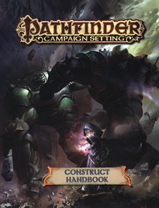 development leads: Adam Daigle, Eleanor Ferron & Luis Loza
development leads: Adam Daigle, Eleanor Ferron & Luis Loza
authors: Brian Duckwitz, Andrew Hoskins, Nathan King et al.
interior artists: Graey Erb, Nicolás Espinoza, Forrest Imel abd Alyssa McCarthy
cover artist: Ignacio Bazán Lazcano
publisher: Paizo Publishing
publication date: 2018
cover: softcover
number of pages: 64
ISBN-10: 1-60125-989-1
ISBN-13: 978-1-60125-989-9
description: This book contains twenty-three new variations on the theme of automatons, clockworks, golems, constructs and robots. This book is compatible with the Pathfinder Role Playing Game.
Our featured entry from this bestiary is the clockwork songbird.
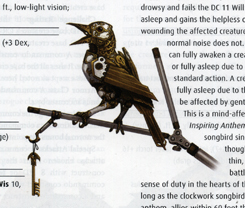 Marvels of machinery and musicality, clockwork songbirds are prized for the beautiful melodies they produce, which can vary based on the songbird's construction. These clockwork creatures often inhabit the homes and gardens of nobility, where they fill opulent manors and wide-open green spaces alike with their lilting songs. Both children and adults delight in clockwork songbirds, with the former seeing these mechanical creatures as amusing toys and the latter as party novelties.
Marvels of machinery and musicality, clockwork songbirds are prized for the beautiful melodies they produce, which can vary based on the songbird's construction. These clockwork creatures often inhabit the homes and gardens of nobility, where they fill opulent manors and wide-open green spaces alike with their lilting songs. Both children and adults delight in clockwork songbirds, with the former seeing these mechanical creatures as amusing toys and the latter as party novelties.
A clockwork songbird is typically no longer than 18 inches and weighs about 5 pounds.
Construction
The inner workings of a clockwork songbird are made of intricately interlocked components, with the most complex machinery located in the creature's voice box. The creator of a clockwork songbird must start with crafted clockwork pieces worth 250 gp.
|
|
|
|
|
January 12, 2019
Guildmaster's Guide to Ravnica
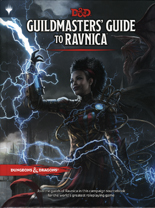 development leads: James Wyatt & Jeremy Crawford
development leads: James Wyatt & Jeremy Crawford
designers: Ari Levitch, Ben Petrisor, Mike Mearls, Robert J. Schwalb & Chris Tulach
interior artists: Deruchenko Alexander et al.
cover artist: Magali Villeneuve
publisher: Wizards of the Coast
publication date: 2018
cover: hardcover
number of pages: 256
ISBN-10: 0-7869-6659-9
ISBN-13: 978-0-7869-6659-2
description: This book is a general source book for a campaign based in Ravnica, which is the world in which the card game, Magic: The Gathering" is set. Of relevance to this survey, Chapter 6. Friends and Foes, from page 183 to 256, presents a bestiary and list of NPCs. This book is compatible with the Fifth Edition Dungeons and Dragons Role Playing Game.
Our featured entry from this bestiary is the fluxcharger, a variety of Izzet weird.
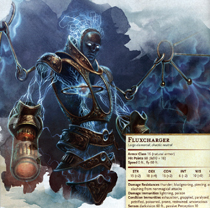 Izzet Weirds
Izzet Weirds
Weirds are the products of Izzet League experiments intended to combine two opposing elemental types in the hope of creating elementals that were more stable than the norm and easier to control. As commonly happens with Izzet experiments, the outcome was the exact opposite. Weirds are even wilder and more unpredictable than elementals of either of their component elements. Nevertheless, they can make potent guardian creatures and can be urged into fighting on behalf of their creators.
Fluxcharger
In an effort to create a weird that could be more easily controlled, Izzet mages tried binding elemental lightning, fire, and smoke into a framework made of the magical alloy mizzium. The experiment was partly successful: the resulting weird, a fluxcharger, doesn't explode like some other weirds do, but it is more intelligent and more headstrong than other weirds.
A fluxcharger's mizzium frame is suggestive of an angel. A faceplate is meant to give it some personality, but most people find its solemn expression and unblinking stare more unnerving than relatable.
|
|
|
|
|
January 19, 2019
The Official National Pokédex: Pokémon Ultra Sun & Pokémon Ultra Moon Edition
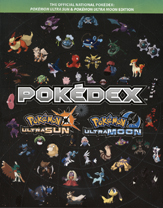 authors: Jillian Nonaka, Sayuri Munday & Shawn Williams-Brown
authors: Jillian Nonaka, Sayuri Munday & Shawn Williams-Brown
design: Chris Franc et al.
publisher: The Pokémon Company International
publication date: 2017
cover: softcover + poster
number of pages: 698
ISBN-10: 0-7440-1936-2
ISBN-13: 978-0-7440-1936-0
description: This book contains descriptions of 806 creatures for the Pokémon game. This book is compatible with the Nintendo
Pokémon video games.
Our featured entry from this bestiary is the Pokémon, Snorlax.
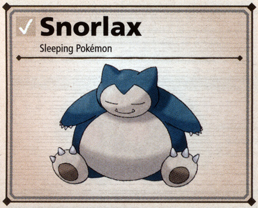 It doesn't do anything other than eat and sleep. When prompted to make a serious effort, thought, it apparently displays awesome power.
It doesn't do anything other than eat and sleep. When prompted to make a serious effort, thought, it apparently displays awesome power.
It has no interest in anything other than eating. Even if you climb up on its stomach while it's napping, it doesn't seem to mind at all.
- National Pokédex: 143
- Alola Pokédex: 043
- Type: Normal
- Height: 6'11"
- Weight: 1014.1 lbs
- Item: Leftovers
- Abilities: Immunity, Thick Fat
- Hidden Ability: Gluttony
- Evolution: Level up Munchlax with high friendship
- Exclusive Z-Move: Pulverizing Pancake
|
|
|
|
|
January 26, 2019
Warhammer Hordes of Chaos
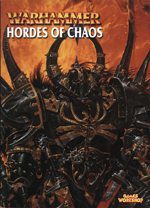 authors: Gavin Thorpe, Rick Priestley, Anthony Reynolds & Alessio Cavatore
authors: Gavin Thorpe, Rick Priestley, Anthony Reynolds & Alessio Cavatore
interior artists: John Blanche et al.
miniature painters: Jocelyn Goyette et al.
cover artist: Adrian Smith
publisher: Games Workshop
publication date: 2002
cover: softcover
number of pages: 112
ISBN-10: 1-84154-222-9
ISBN-13: 978-1-84154-222-5
description: This book contains descriptions of the troops from the northern Chaos Wastes, including both the mortal and daemonic warriors of the Gods of Chaos. This book is compatible with the Warhammer Role Playing Game.
Our featured entry from this bestiary is the chaos dragon.
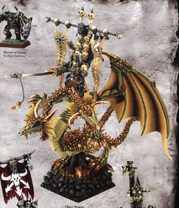 Once the proud and noble rulers of the skies, now split, changed and shredded by the forces of change, the terrible two-headed Dragons of Chaos are the offspring of the ancient drake Galrauch. Borne aloft on wings no longer merely of flesh and bone, its muscles and organs are open to the world. Wreathed in smoke and flame, the Chaos Dragon is the mightiest beast of the north, a terrifying nemesis of all order and sanity that can break the backs of armies with its steel claws and teeth. Chaos Dragons are invariably wicked creatures. as fickle as the god Tzeentch who originally spawned them.
Once the proud and noble rulers of the skies, now split, changed and shredded by the forces of change, the terrible two-headed Dragons of Chaos are the offspring of the ancient drake Galrauch. Borne aloft on wings no longer merely of flesh and bone, its muscles and organs are open to the world. Wreathed in smoke and flame, the Chaos Dragon is the mightiest beast of the north, a terrifying nemesis of all order and sanity that can break the backs of armies with its steel claws and teeth. Chaos Dragons are invariably wicked creatures. as fickle as the god Tzeentch who originally spawned them.
In times of war the Chaos Dragons feel the call of the gods as much as all other creatures of Chaos. and some have been known to join the armies of the north as they march against the soft-bellied southerners. Only the most powerful Lords of Chaos can bend such a beast to their will and ride into battle mounted atop such a monster, and even then it is more an unholy alliance of destruction than a matter of master and servant.
|
|
|
|
|
February 2, 2019
Warhammer Beasts of Chaos
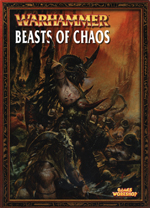 author: Gav Thorpe
author: Gav Thorpe
interior artists: John Blanche, Alex Boyd, Paul Dainton, Nuala Kennedy, Karl Kopinski & Adrian Smith
cover artist: Paul Dainton
miniatures painters: Kev Asprey et al.
publisher: Games Workshop
publication date: 2003
cover: softcover
number of pages: 80
ISBN-10: 1-84154-387-X
ISBN-13: 978-1-84154-387-1
description: This book contains a description of creatures that populate the hordes of the Beastmen. This book is compatible with the Warhammer Role Playing Game.
Our featured entry from this bestiary is the centigor.
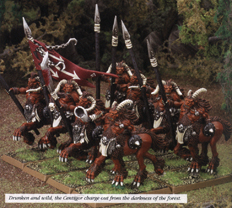 Centigors are a disturbing cross between four-legged creatures, such as horses and oxen, and the bipedal beasts of Chaos, merged together by the warping powers of the Wastes some tame in ages past. They possess the hindquarters and forelegs of their quadruped ancestors, granting them great speed and strength, but the upper body of a humanoid with which they wield brutal weapons.
Centigors are a disturbing cross between four-legged creatures, such as horses and oxen, and the bipedal beasts of Chaos, merged together by the warping powers of the Wastes some tame in ages past. They possess the hindquarters and forelegs of their quadruped ancestors, granting them great speed and strength, but the upper body of a humanoid with which they wield brutal weapons.
Strong of limb and fleet of foot, These beast-centaurs are powerful creatures However, they are not especially agile, and while they have great strength they lack the dexterity to manipulate objects with any skill or control. Centigors are bitter and spiteful, resenting their awkward nature, and harbour a deep jealousy of creatures whose minds and bodies are better matched. Centigors live on the northern and eastern edges of the forests of the Old World, where the trees reluctantly yield to the sparse grasslands of the Northern Wastes They are nomadic, without settlements or even encampments of any kind, finding what little protection they need in the lee of cliffs and natural rock shelters. Often they will join the warband of a Chaos Champion, for the rewards of violence and plunder from such an allegiance are great.
Drunken: Centigors are inclined to drink vast quantities of noxious beer and looted wine and spirits before battle, working themselves up into a drunken frenzy. While this makes them heedless of danger, and can turn them into berserk fighters, it can also severely incapacitate them.
|
|
|
|
|
February 9, 2019
Warhammer Daemons of Chaos
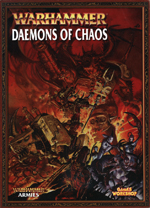 author: Mat Ward
author: Mat Ward
interior artists: John Blanche, Alex Boyd, Paul Dainton, Mark Gibbons & Ian Miller
cover artist: Adrian Smith
publisher: Games Workshop
publication date: 2007
cover: softcover
number of pages: 96
ISBN-10: 1-84154-883-9
ISBN-13: 978-1-84154-883-8
description: This book contains complete descriptions for the daemonic servants of the four Chaos Gods. This book is compatible with the Warhammer Role Playing Game.
Our featured entry from this bestiary is a Lord of Change, the Eye of Tzeentch.
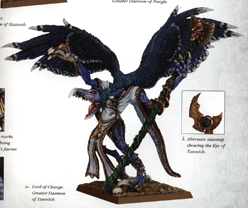 Lords of Change are the most bizarre of all Greater Daemons. They have bright, multi-coloured wings, a gigantic bird-like face and skin that writhes with unnatural energies - indeed, magic courses through their daemonic bodies as blood pumps through that of a mortal. Lords of Change are often blue or yellow, but individuals may change colour if it suits them, adopting a striking plumage suffused with all the colours of the rainbow. Lords of Change do not regard it as essential to retain consistency of colour, appearance - or even shape - unless it pleases them to do so. Of all its splendoured features, a Lord of Change's most striking aspect is its eyes, for within the depths of its gaze lies all the knowledge and insight of Tzeentch. Few mortals can withstand the scrutiny of its gaze, and it is said that when a Lord of Change looks upon a mortal it perceives not only the creature's ephemeral flesh but also the ultimate failure or realisation of its hopes and dreams as well.
Lords of Change are the most bizarre of all Greater Daemons. They have bright, multi-coloured wings, a gigantic bird-like face and skin that writhes with unnatural energies - indeed, magic courses through their daemonic bodies as blood pumps through that of a mortal. Lords of Change are often blue or yellow, but individuals may change colour if it suits them, adopting a striking plumage suffused with all the colours of the rainbow. Lords of Change do not regard it as essential to retain consistency of colour, appearance - or even shape - unless it pleases them to do so. Of all its splendoured features, a Lord of Change's most striking aspect is its eyes, for within the depths of its gaze lies all the knowledge and insight of Tzeentch. Few mortals can withstand the scrutiny of its gaze, and it is said that when a Lord of Change looks upon a mortal it perceives not only the creature's ephemeral flesh but also the ultimate failure or realisation of its hopes and dreams as well.
As manifestations of the Changer of Ways, the Lords of Change are hideously unpredictable and manipulative. Behind the gaze of a Lord of Change lies a curious and wreckful mind, deeply intelligent, yet as uncaring of consequence as it is fascinated by it. The Lord of Change is like a child playing upon some gigantic anthill, poking with a stick at its inhabitants and laughing at the hopeless antics of their defence. Nothing pleases him more than to see the world broken and made anew, to redirect the course of a life or even history itself, spilling hope upon the ground while raising the ambition of others up to an unexpected pinnacle of power.
As might be expected of a creature born of pure magic and bound to the will of the Master of Sorcery, a Lord of Change is a potent spellcaster. The winds of magic obey its every command, allowing it to summon whirling tempests of change and mutation, blast the enemies of Tzeentch with bolts of multi-coloured fire or unravel the mind of an enemy spellcaster from the inside. Sorcery is not the only weapon at the command of a Lord of Change - it is also an erudite tactician, well versed in a thousand ploys and strategems for any given situation. Accordingly, if a Lord of Change prefers to remain uncommitted in battle it is not through lack of courage or ferocity, but because it likes to direct its forces and better control the flow of the fighting. It instinctively sees the skeins of fate that play over the battlefield, and knows all too well how they can be manipulated.
Although a Lord of Change elects to use magic and trickery to further its ends, it is still a fearsome fighter, with talons that can pierce the thickest amour. Over the millennia, countless heroes have underestimated these strange creatures, thinking their wiry frames and fluttering wings fragile, only realising the depth of their misjudgement when their lances and swords shatter against the daemon's immortal skin.
|
|
|
|
|
February 16, 2019
Warhammer Dwarves
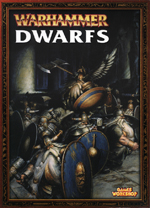 authors: Gav Thorpe & Alessio Cavatore
authors: Gav Thorpe & Alessio Cavatore
interior artists: John Blanche et al.
cover artist: Paul Dainton
publisher: Games Workshop
publication date: 2000
cover: softcover
number of pages: 80
ISBN-10: 1-84154-066-8
ISBN-13: 978-1-84154-066-5
description: This book contains complete descriptions for units in a dwarven army. This book is compatible with the Warhammer Role Playing Game.
Our featured entry from this bestiary are dwarven trollslayers.

Most Dwarf armies will field a unit of Trollslayers. These self exiled Dwarfs are unique amongst the Dwarf
units in that they don't wear armour and dye their beards a bright orange colour.
Dwarfs are very proud individuals and do onot cope well with failure or personal loss. When a tragedy occurs, a Dwarf may be driven to take the oath of the Slayer. He will break all ties with his Hold and his clan and seek death by hunting down and fighting a monstrous beast. Many achieve their wish to die at the hands of a foul creature, but some survive to fight more beasts until the day they meet their final destiny.
|
|
|
|
|
February 23, 2019
Warhammer Dark Elves
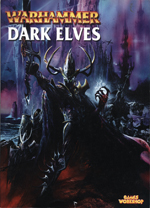 authors: Gav Thorpe, Space James McQuirk & Tuomas Pirinen
authors: Gav Thorpe, Space James McQuirk & Tuomas Pirinen
interior artists: David Gallagher
cover artist: Geoff Taylor
publisher: Games Workshop
publication date: 2001
cover: softcover
number of pages: 80
ISBN-10: 1-84154-083-8
ISBN-13: 978-1-84154-083-2
description: This book contains complete descriptions for units in a dark elven army. This book is compatible with the Warhammer Role Playing Game.
Our featured entry from this bestiary is the chariot drawn by cold ones.
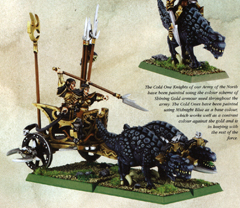 It is a symbol of great prestige to ride into battle upon the magnificent chariots of Naggarond. These are given as gifts to warriors who have pleased our lord Malekith with their devotion, bravery and prowess in battle. Accompanied by the roars of the Cold Ones and the thunder of wheels across the battlefield, a chariot smashing into the enemy is a sight magnificent to behold. Until recently the Witch King himself rode to battle in such fashion, altbough in his wisdom our King has now renounced his decree for the Great Reclamation of our homeland, be once ruled that only he and no other was worthy of such a mount.
It is a symbol of great prestige to ride into battle upon the magnificent chariots of Naggarond. These are given as gifts to warriors who have pleased our lord Malekith with their devotion, bravery and prowess in battle. Accompanied by the roars of the Cold Ones and the thunder of wheels across the battlefield, a chariot smashing into the enemy is a sight magnificent to behold. Until recently the Witch King himself rode to battle in such fashion, altbough in his wisdom our King has now renounced his decree for the Great Reclamation of our homeland, be once ruled that only he and no other was worthy of such a mount.
|
|
|
|
|
March 2, 2019
Warhammer Vampire Counts
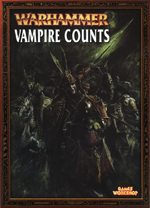 authors: Alessio Cavatore et al.
authors: Alessio Cavatore et al.
interior artists: Alex Boyd et al.
cover artist: Alex Boyd
publisher: Games Workshop
publication date: 2001
cover: softcover
number of pages: 80
ISBN-10: 1-84154-080-3
ISBN-13: 978-1-84154-080-1
description: This book contains complete descriptions for units in an undead army, led by vampiric generals. This book is compatible with the Warhammer Role Playing Game.
Our featured entry from this bestiary is the black coach.
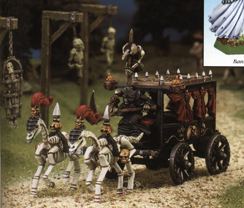 Once a particularly powerful Vampire is slain, it is not certain that the world will be rid of this predator of the night. Many of the greatest lords of Undeath have returned after their bodies have been destroyed, for who can say which is the master, death or the Vampire?
Once a particularly powerful Vampire is slain, it is not certain that the world will be rid of this predator of the night. Many of the greatest lords of Undeath have returned after their bodies have been destroyed, for who can say which is the master, death or the Vampire?
If the servants of a particularly powerful Vampire can gather his ashes (for once a Vampire's life is taken, its body will feel the weight of time and crumble to dust) they will construct a coffin to keep them safe. Then by performing unholy rituals they will create a carriage to carry the remains of their lord and take it to places of slaughter. Battlefields and plague-ridden cities in particular strengthen the regenerating spirit of the Vampire.
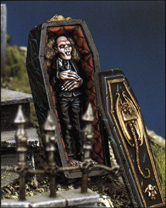 This ghostly apparition is driven by an insubstantial Wraith and pulled by two grisly Nightmares. The legends say that even if the creatures are destroyed, the Coach can continue to move on its own pushed by supernatural powers. The Black Coach is an awe-inspiring, unholy thing from the realm of Undeath, which feeds on the souls of mortals. Its mere presence can drain the lifeblood of men and the more it slays, the more terrifying its power becomes.
This ghostly apparition is driven by an insubstantial Wraith and pulled by two grisly Nightmares. The legends say that even if the creatures are destroyed, the Coach can continue to move on its own pushed by supernatural powers. The Black Coach is an awe-inspiring, unholy thing from the realm of Undeath, which feeds on the souls of mortals. Its mere presence can drain the lifeblood of men and the more it slays, the more terrifying its power becomes.
Few symbols of death are as horrifying for mortals, or as potent an aid to the Undead. It is said that the blood of ten thousand mortals can stir the Vampire Lord from his slumber, ready to walk the land of the living once more.
|
|
|
|
|
March 9, 2019
Warhammer Tomb Kings
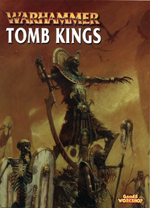 authors: Alessio Cavatore et al.
authors: Alessio Cavatore et al.
interior artists: John Blanche et al.
cover artist: Paul Dainton
publisher: Games Workshop
publication date: 2002
cover: softcover
number of pages: 80
ISBN-10: 1-84154-336-5
ISBN-13: 978-1-84154-336-9
description: This book contains complete descriptions for units in an undead army, led by mummies. This book is compatible with the Warhammer Role Playing Game.
Our featured entry from this bestiary is the tomb scorpion.
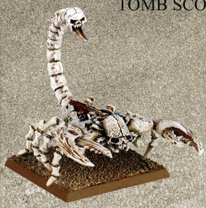 Tomb Scorpions are powerful creations of the Liche Priests, giant constructs carved and moulded into representations of the giant, mystical creatures said to guard the entrance to the Nehekharan underworld. They are formed from a combination of materials: stone. wood and metal, together with the hones and shells of long dead mighty creatures that are scattered beneath the sands of the desert. Through laborious and precise incantations, the Liche Priests join the materials into a single form. The Tomb Scorpion serves as a sarcophagus or tomb itself, for the shell of the construct is formed around the cadaverous body of one of the ancient High Priests. For reasons unknown, some of these ancient ones no longer respond to the Incantations of Awakening and have fallen into what is known as the Death Sleep.
Tomb Scorpions are powerful creations of the Liche Priests, giant constructs carved and moulded into representations of the giant, mystical creatures said to guard the entrance to the Nehekharan underworld. They are formed from a combination of materials: stone. wood and metal, together with the hones and shells of long dead mighty creatures that are scattered beneath the sands of the desert. Through laborious and precise incantations, the Liche Priests join the materials into a single form. The Tomb Scorpion serves as a sarcophagus or tomb itself, for the shell of the construct is formed around the cadaverous body of one of the ancient High Priests. For reasons unknown, some of these ancient ones no longer respond to the Incantations of Awakening and have fallen into what is known as the Death Sleep.
That these beings are truly dead IS doubtful, as their power can still be felt exuding from their skeletal bodies.
The shell of the inanimate scorpion is inscribed with hieroglyphs of binding, and a ceremony of awakening is spoken. The ceremony lasts from moon rise until the first rays of dawn, and any mistakes or mispronunciations will mean that the incantation will fail. If the ritual has been performed correctly, the Tomb Scorpion will become infused with the residual power of the priest held within. Tomb Scorpions often stand dormant for centuries on end, and become buried by the shifting sands. When the Tomb Kings go to war, the Liche Priests send out their call, and the Tomb Scorpions awake, clawing their to the surface to fall upon their enemies with mighty claws and stinging tails. It is truly a terrifying sight to behold the sands shift and part as the monstrous creations worktheir way to the surface!
|
|
|
|
|
March 16, 2019
Warhammer Lizardmen
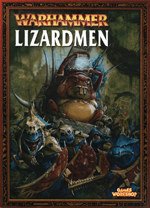 authors: Anthony Reynolds et al.
authors: Anthony Reynolds et al.
interior artists: John Blanche et al.
cover artist: Alex Boyd
publisher: Games Workshop
publication date: 2003
cover: softcover
number of pages: 80
ISBN-10: 1-84154-356-X
ISBN-13: 978-1-84154-356-7
description: This book contains complete descriptions for units in a lizardman army. This book is compatible with the Warhammer Role Playing Game.
Our featured entry from this bestiary is the stegadon.
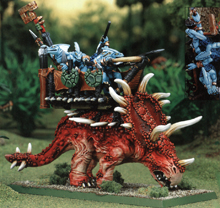 The hostile jungles are home to a phenomenal array of creatures, almost all deadly in their own way. Stegadons are among the largest and most aggressive of all. They are ancient creatures that were living in the jungles of Lustria when the Old Ones first arrived. Gigantic, armoured beasts, they feed on almost anything they come across, from the lush vegetation and the trunks of vast forest trees, to the flesh of any creature foolish enough to get in their way. They are strong enough to uproot entire trees, and they can crack stone with their heavy footfalls. In the heat of the jungle, the Stegadons cool themselves by wallowing in the swamps, relying on their thick scaly hide to protect them from crocodiles and the gigantic predatory fish that infest the waters.
The hostile jungles are home to a phenomenal array of creatures, almost all deadly in their own way. Stegadons are among the largest and most aggressive of all. They are ancient creatures that were living in the jungles of Lustria when the Old Ones first arrived. Gigantic, armoured beasts, they feed on almost anything they come across, from the lush vegetation and the trunks of vast forest trees, to the flesh of any creature foolish enough to get in their way. They are strong enough to uproot entire trees, and they can crack stone with their heavy footfalls. In the heat of the jungle, the Stegadons cool themselves by wallowing in the swamps, relying on their thick scaly hide to protect them from crocodiles and the gigantic predatory fish that infest the waters.
Massive horns project from the Stegadons' armoured crests, and their bodies are covered in spikes and bony armour plating. Their tails are heavy and barbed, and can be swung with devastating force. Highly territorial, a Stegadon will charge any creature invading its territory, destroying anything in its path. Disputes between rival male Stegadons can be heard for miles around, their roars reverberating through the jungle as the massive beasts fight. Often, these battles last for days on end, and are resolved only when one of the competitors has been slain, to be consumed by the victor.
In battle, howdahs are attached to the backs of these giant beasts, crewed by a flock of Skinks. Stegadons are terrifying and lethal in battle, crushing anything beneath their massive bulk and scattering the enemies of the lizardmen.
|
|
|
|
|
March 23, 2019
Warhammer Ogre Kingdoms
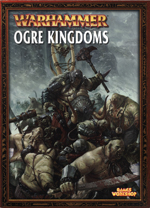 authors: Phil Kelly et al.
authors: Phil Kelly et al.
interior artists: Alex Boyd et al.
cover artist: Karl Kopinski
publisher: Games Workshop
publication date: 2004
cover: softcover
number of pages: 80
ISBN-10: 1-84154-531-7
ISBN-13: 978-1-84154-531-8
description: This book contains complete descriptions for units in an ogre army. This book is compatible with the Warhammer Role Playing Game.
Our featured entry from this bestiary is the butcher.
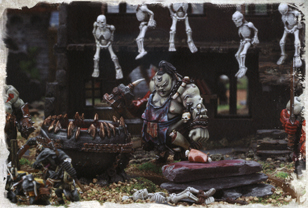 Butchers are immense, corpulent hulks covered in offal and dried blood. They have appalling personal hygiene and like nothing more than wallowing in meat, guts and gore regardless of its source. Hideous and mean, Butchers are essentially the Ogre equivalent of a tribal shaman, although their role is more that of holy man than magic-user. They have a direct link to the Great Maw, and are able to channel a small portion of the Ogre deity's insatiable thirst for gluttony and violence in a practice known as 'Gut Magic'. A Butcher is also directly responsible for preparing his tribe's Feasts, the closest the Ogres have to a religious festival. Finally, during their induction into the cult of the Great Maw, the Butchers are taught how to tame fire. As firemaster, shaman and head chef, Butchers wield an amount of influence within each Ogre kingdom second only to the Tyrant himself. Twinned with their malign intellect, it is not uncommon for the hoarse whispers of a tribe's Butcher to dictate the bellowed commands of his Tyrant.
Butchers are immense, corpulent hulks covered in offal and dried blood. They have appalling personal hygiene and like nothing more than wallowing in meat, guts and gore regardless of its source. Hideous and mean, Butchers are essentially the Ogre equivalent of a tribal shaman, although their role is more that of holy man than magic-user. They have a direct link to the Great Maw, and are able to channel a small portion of the Ogre deity's insatiable thirst for gluttony and violence in a practice known as 'Gut Magic'. A Butcher is also directly responsible for preparing his tribe's Feasts, the closest the Ogres have to a religious festival. Finally, during their induction into the cult of the Great Maw, the Butchers are taught how to tame fire. As firemaster, shaman and head chef, Butchers wield an amount of influence within each Ogre kingdom second only to the Tyrant himself. Twinned with their malign intellect, it is not uncommon for the hoarse whispers of a tribe's Butcher to dictate the bellowed commands of his Tyrant.
So different are the Butchers from the simple bulls of their tribe that they are treated with an equal mix of reverence, awe and suspicion. It is said that an Ogre whelp that draws blood instead of milk from its mother's teat is marked by the Great Maw. That infant will be immediately taken into the custody of the tribe's Butcher, who will bite deep into the whelp's gut to claim it as his own. The Butcher will then allow the whelp to glut itself continually on blood and raw meat until his protegé has grown fat and strong. During the whelp's upbringing it will be initiated into the secrets of the Great Maw, and taught to gulp down and digest the most foul and poisonous substances, ranging from ragged hunks of rotten meat to ground-up bedrock and the slimy, toxic intestines of stone trolls. An adult Butcher takes pride in the fact he can consume substances that would ravage the digestive systems of even his fellow Ogres. Furthermore, Butchers traditionally do not try to hide their sprawling, flabby bellies with gutplates, trusting the blessing of the Great Maw to be protection enough This gastronomic fortitude is a great source of respect from the rest of the tribe, who believe that to cross a Butcher is to cross the Great Maw itself and therefore doom themselves to premature reincarnation as a hot and
nourishing stew.
Butchers often resemble walking larders, such is their propensity to carry chunks of meat and other less savoury ingredients around with them...
|
|
|
|
|
March 30, 2019
Warhammer Wood Elves
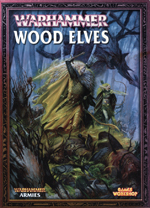 authors: Anthony Reynolds & Matthew Ward et al.
authors: Anthony Reynolds & Matthew Ward et al.
interior artists: John Blanche et al.
cover artist: Paul Dainton
publisher: Games Workshop
publication date: 2005
cover: softcover
number of pages: 80
ISBN-10: 1-84154-680-1
ISBN-13: 978-1-84154-680-3
description: This book contains complete descriptions for units in a wood elven army. This book is compatible with the Warhammer Role Playing Game.
Our featured entry from this bestiary is the treeman.
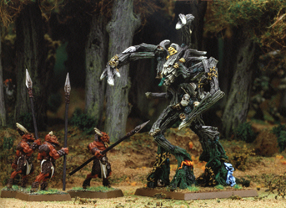 Some of the more powerful and ancient of Athel Loren's spirits are able to entwine their essence with that of a living tree, moulding it to their will. It is not a decision taken lightly for, when a spirit forms a bond with a living tree, they become irrevocably merged and cannot choose to leave - only death can sever the connection. From that moment on, the will of the spirit shapes and drives the tree, using knotted bark and gnarled branches to serve where an insubstantial spirit form cannot. Terrifying to behold, these behemoths smash apart all who stand against them, and are almost impervious to harm. Foes are swallowed whole by gaping mouths that open in the trunks of these mighty beings, the corpses providing the host tree with nourishment for many years. These mighty Treemen are revered by Elf and forest-creature alike, and are often infested with lesser spirits living amongst their branches, roots and hollows. These incredibly ancient beings have seen entire races rise and fall like the ascent and descent of the sun, and understand the passing of time in a completely different way to mortal creatures. Even the long-lived Elves seem to pass into dust at an alarming rate to these Treemen, the oldest of whom can remember times before the footsteps of the Elves left a mark upon the world and can expect to remain when the Elves walk no more.
Some of the more powerful and ancient of Athel Loren's spirits are able to entwine their essence with that of a living tree, moulding it to their will. It is not a decision taken lightly for, when a spirit forms a bond with a living tree, they become irrevocably merged and cannot choose to leave - only death can sever the connection. From that moment on, the will of the spirit shapes and drives the tree, using knotted bark and gnarled branches to serve where an insubstantial spirit form cannot. Terrifying to behold, these behemoths smash apart all who stand against them, and are almost impervious to harm. Foes are swallowed whole by gaping mouths that open in the trunks of these mighty beings, the corpses providing the host tree with nourishment for many years. These mighty Treemen are revered by Elf and forest-creature alike, and are often infested with lesser spirits living amongst their branches, roots and hollows. These incredibly ancient beings have seen entire races rise and fall like the ascent and descent of the sun, and understand the passing of time in a completely different way to mortal creatures. Even the long-lived Elves seem to pass into dust at an alarming rate to these Treemen, the oldest of whom can remember times before the footsteps of the Elves left a mark upon the world and can expect to remain when the Elves walk no more.
|
|
|
|
|
April 6, 2019
Warhammer The Empire
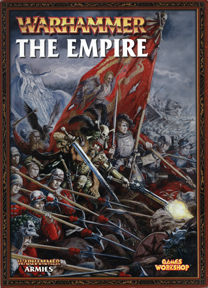 authors: Graham McNeill et al.
authors: Graham McNeill et al.
interior artists: John Blanche et al.
cover artist: David Gallagher
publisher: Games Workshop
publication date: 2006
cover: softcover
number of pages: 96
ISBN-10: 1-84154-799-9
ISBN-13: 978-1-84154-799-2
description: This book contains complete descriptions for units in the human imperial army. This book is compatible with the Warhammer Role Playing Game.
Our featured entry from this bestiary is the Flagellant Warband.
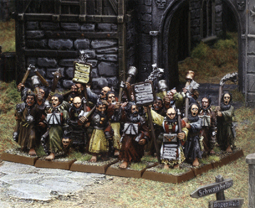 The terrible plagues and wars of recent years, combined with prophecies of the Lord of the End Times and the doom of the world, has filled the hearts of the Empire's people with despair and hopelessness. In the wake of such calamities come hardship and terror as death stalks the landscape and entire towns are wiped from the face of the Empire. It is small wonder that many of these dispossessed folk go mad from the hopelessness and horror of their situation. To many, the wretched state of the world is seen as proof that its doom is at hand and only by bloody penitence and self-flagellation can it be saved. Such unfortunates flock to hear the despairing pronouncements of lunatic doomsayers, and these bands of Flagellants roam the Empire at will, spreading their gospel of desolation before them.
The terrible plagues and wars of recent years, combined with prophecies of the Lord of the End Times and the doom of the world, has filled the hearts of the Empire's people with despair and hopelessness. In the wake of such calamities come hardship and terror as death stalks the landscape and entire towns are wiped from the face of the Empire. It is small wonder that many of these dispossessed folk go mad from the hopelessness and horror of their situation. To many, the wretched state of the world is seen as proof that its doom is at hand and only by bloody penitence and self-flagellation can it be saved. Such unfortunates flock to hear the despairing pronouncements of lunatic doomsayers, and these bands of Flagellants roam the Empire at will, spreading their gospel of desolation before them.
When war threatens, bands of crazed Flagellants instinctively gravitate towards battlefields, appearing unannounced and charging headlong towards the enemy without fear or hesitation. Flagellants fight in a crazed frenzy, driven insane by the horrors the world has inflicted upon them and desperate for their pain to end. Heedless of danger and injury, they will fight until each and every one of them is dead, thus vindicating their belief that the end is indeed nigh...
|
|
|
|
|
April 13, 2019
Warhammer High Elves
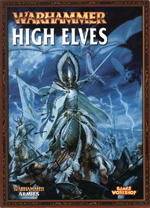 authors: Adam Troke et al.
authors: Adam Troke et al.
interior artists: Paul Dainton et al.
cover artist: Paul Dainton
publisher: Games Workshop
publication date: 2007
cover: softcover
number of pages: 102
ISBN-10: 1-84154-846-4
ISBN-13: 978-1-84154-846-3
description: This book contains complete descriptions for units in a high elven army. This book is compatible with the Warhammer Role Playing Game.
Our featured entry from this bestiary is a dragon mage of Caledor.
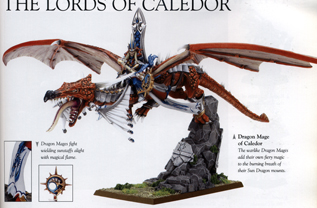 Dragon Princes of Caledor
Dragon Princes of Caledor
Caledor is the fabled land of Dragons, where in ancient times princes of royal blood would ride Dragons to battle. The Dragon Princes, as they were called, were the greatest warriors in all of Ulthuan, champions of the wars against the Daemons and the civil war wrought by the Witch King.
Once, Caledor was the supreme realm amongst the Elven kingdoms, but now its power has waned, its Dragons are diminished in size and number, and they spend long centuries in a deep sleep from which they can seldom be roused. Today there are still Dragons slumbering in their lairs in the Dragon Spine Mountains and the caves beneath Vaul's Anvil...
Dragon Mages
The first known Dragon Mage was Caelith Fireheart. Born in the last year of Aethis the Poet's reign, Caelith was little more than a child in the eyes of the High Elves when he claimed one of the famed Sunstaffs from the Caves of Dreaming and awoke the Sun Dragon Rilgaur. Caelith and the newly awoken Rilgaur brought aid to the army of Mentheus at Griffon Gate, leading a devastating charge that crushed the flank of the Dark Elf host and allowed the wily old Mentheus to rout the enemy from the field. When the fighting was over, Mentheus greeted Caelith and first coined the name Dragon Mage in reference to the courageous young Mage.
In every generation since, a handful of Dragon Mages have emerged from the aspirant Mages studying the Winds of Magic at the Tower of Hoeth. They are found among the most impetuous and fiery students, and almost without exception they are of Caledorian descent. Once they begin to study the Lore of Fire, the first of the Lores taught at the Tower, their aggressive and warlike nature becomes even more apparent. Each is plagued by dreams of fire and blood, in which they ride upon Dragons the colour of the setting sun. Soon the only desire of these youths is to seek out their destiny as a Dragon Mage. Indeed, once they have been approved as competent with Fire magic by their tutors at the Tower, they set off on the long journey back to Caledor and the caves below the Dragon Spine Mountains.
To awaken a Dragon from slumber is a process that can take months, or even years, and yet these impetuous Mages from Caledor take to the task as if born to it. No sooner does a Dragon Mage enter the sulphur-clogged caverns below the Dragon Spine than the dormant Sun Dragons grow restive. Instinctively, and with no instruction, the Dragon Mage will approach one of the sleeping beasts and call it by name - awakening the Sun Dragon fully. Only a Sun Dragon will hear the call of a Dragon Mage and rise for battle - the older and wiser Dragons of the Moon and Stars are not given to such passion and recklessness, awaiting a steadier mind to rouse them.
The Dragon Mages of Caledor have earned themselves a reputation as wild and uncontrolled, qualities that are not normally seen favourably by the High Elves. Yet despite this, the Elves of Ulthuan look upon these fiery youths and the ease with which they bring the Dragons to war, and in them see hope reborn.
|
|
|
|
|
April 20, 2019
Warhammer Skaven
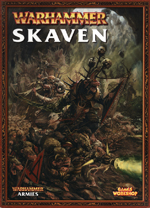 authors: Jeremy Vetock et al.
authors: Jeremy Vetock et al.
interior artists: John Blanche et al.
cover artist: uncredited
publisher: Games Workshop
publication date: 2009
cover: softcover
number of pages: 112
ISBN-10: 1-84154-943-6
ISBN-13: 978-1-84154-943-9
description: This book contains complete descriptions for units in a skaven army. This book is compatible with the Warhammer Role Playing Game.
Our featured entry from this bestiary is the plague furnace.
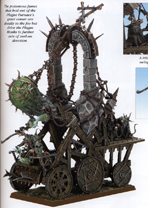 The Plague Furnace is a disease-ridden altar to the Great Horned Rat and an unholy pulpit for a Plague Priest. It is the noisome shrine of Clan Pestilens and ruination and corruption travel in its wake.
The Plague Furnace is a disease-ridden altar to the Great Horned Rat and an unholy pulpit for a Plague Priest. It is the noisome shrine of Clan Pestilens and ruination and corruption travel in its wake.
The Plague Furnace is pushed into battle by chanting Plague Monks, the creaking of its iron-shod wheels audible above the drone of devotional maledictions. The decaying chassis of the Plague Furnace is riddled with woodworm, but it is the vast and ornate swinging brazier that commands attention. A glowing hot censer of wrecking ball proportions swings back and forth, issuing overwhelming heat and a roiling cloud that even simple beasts instinctively recognise as poisonous and unnatural. The rhythmic swings of the infernal furnace produce an ominous sound as the pendulous censer drags through the air, leaving a trail of deadly fumes. It stings the eyes and assails the senses to gaze at the shimmering heat of the swaying globe. As the greenish vapours drift over the Plague Monks, it wets their tattered robes. This befouled fog begins to make the pox-ridden brethren twitch, their eyes bulging out in an unholy fervour for battle and blood-letting.
As the Plague Furnace nears-the foe, the Plague Monks strain more feverishly at the ropes, increasing the momentum of the blazing orb. As the frothing brotherhood crash the Plague Furnace into the enemy battleline, the rusty chains holding the great warpstone incinerator are let slip so the vast censer plummets into the middle of the enemy unit. The unholy payload continues to spew the deadly green-tinged warpstone fumes while it is hoisted back into place.
|
|
|
|
|
April 27, 2019
Warhammer Orcs & Goblins
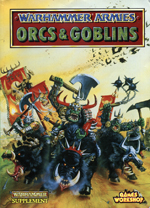 author: Rick Priestley
author: Rick Priestley
interior artists: John Blanche et al.
cover artist: Dave Gallagher
publisher: Games Workshop
publication date: 1996
cover: softcover
number of pages: 122
ISBN-10: 1-872372-64-3
ISBN-13: 978-1-872372-64-8
description: This book contains complete descriptions for units in a globinoid army. This book is compatible with the Warhammer Role Playing Game.
Our featured entry from this bestiary is the night goblin squig hunters.
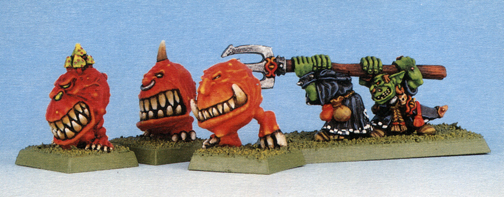
Night Goblins cultivate different kinds of fungus and moulds in their meandering caves and tunnels. They also descend into the deeper caverns to search for the wild and exotic funguses which they use to make powerful magic potions. Night Goblins are not the only creatures that like to eat fungus, so they have to be constantly on the look out for dangerous subterranean denizens. One of the most deadly of all these creatures is the elusive Cave Squig. These are hybrid creatures, part fungus and part flesh, with tough ball-shaped bodies and clumsy taloned feet. Cave Squigs have huge gaping mouths thronged with slashing teeth, and an enraged Cave Squig can bite a large creature clean in two and can easily swallow a Night Goblin whole.
Over the many hundreds of years that Night Goblins have lived in the tunnels they have become quite used to dealing with these fearsome creatures. Roasted Cave Squig is considered a great delicacy and captive Cave Squigs are kept as pets by Night Goblin Chieftains.
Night Goblins hunt Cave Squigs using long, sturdy forks called 'prodders' to goad the Squigs from their hiding places and to keep the enraged beasts at bay. Once a Squig has been provoked from its lair the Night Goblins throw nets over it then bash it senseless with large clubs so it can be safely dragged away. Some Night Goblins become very proficient Squig hunters and come to be quite nonchalant about the dangers involved. Famous Squig hunters are happy to exhibit their skills with daring spectacles such as Squig wrestling, tunnel racing, Squig pit leaping, and bare-back Squig riding.
|
|
|
|
|
May 4, 2019
Warhammer 40,000 Tyranids
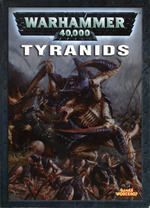 authors: Phil Kelly, Andy Chambers et al.
authors: Phil Kelly, Andy Chambers et al.
interior artists: Paul Dainton et al.
cover artist: Alex Boyd
publisher: Games Workshop
publication date: 2004
cover: softcover
number of pages: 64
ISBN-10: 1-84154-650-X
ISBN-13: 978-1-84154-650-6
description: This book contains a complete description of the units in the alien Tyranid army. This book is compatible with the Warhammer 40,000 Role Playing Game.
Our featured entry from this bestiary is the carnifex.
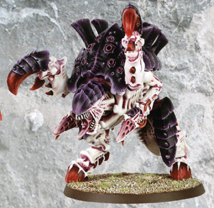 Imperial Designation: Carnifex
Imperial Designation: Carnifex
Common Name: Screamer-Killer
Species Name: Carnifex Voracio, Carnifex Ululare, Carnifex Arbilys
The Carnifex is a living engine of destruction evolved for use in shock assaults, space ship boarding actions and massed battles where it can smash through almost any obstacle, whether it is a defensive line, enemy tanks or a fortified position. The assault of these creatures is terrifying to behold, a primeval force which smashes men and vehicles aside like children's toys.
|
|
|
|
|
May 11, 2019
Warhammer 40,000 Eldar
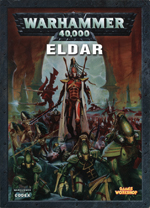 author: Rick Priestley (original book)
author: Rick Priestley (original book)
interior artists: John Blanche et al.
cover artist: Paul Dainton
publisher: Games Workshop
publication date: 2006
cover: softcover
number of pages: 80
ISBN-10: 1-84154-791-3
ISBN-13: 978-1-84154-791-6
description: This book contains a complete description of the units in the Eldar army. This book is compatible with the Warhammer 40,000 Role Playing Game.
Our featured entry from this bestiary is the Farseer Eldrad Ulthran of the Ulthwé Craftworld.
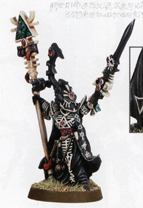 Craftworld Ulthwé is home to the most powerful psykers in the galaxy. The Eldar of Ulthwé have cast themselves as sentinels, keeping an endless vigil over the Eye of Terror. They maintain that their elite cadres of Farseers and Warlocks are needed to keep watch for the many and varied guises of Chaos. Other craftworlds whisper that Ulthwé has damned itself - that the Eye of Terror that has tainted the inhabitants of Ulthwé and exaggerated their psychic potential.
Craftworld Ulthwé is home to the most powerful psykers in the galaxy. The Eldar of Ulthwé have cast themselves as sentinels, keeping an endless vigil over the Eye of Terror. They maintain that their elite cadres of Farseers and Warlocks are needed to keep watch for the many and varied guises of Chaos. Other craftworlds whisper that Ulthwé has damned itself - that the Eye of Terror that has tainted the inhabitants of Ulthwé and exaggerated their psychic potential.
Ulthwé's many talented psykers can foresee future events with a greater precision than those of other craftworlds. This foresight allows them both to preserve their line and thwart their eternal enemies, the forces of Chaos. Of all the craftworlds, it is Ulthwé that intervenes most in the affairs of other races to further their own agenda.
Once led by the legendary Farseer Eldrad Ulthran, the Seer Council of Ulthwé has constantly influenced the course of history. At the behest of the Council, the craftworld's warriors are frequently sent into apparently unrelated battles that will ultimately concern Ulthwé itself. It is largely from these seemingly arbitrary conflicts that the Eldar have earned their reputation for random and capricious behaviour. But the Farseers of Ulthwé know well that stopping the fall of a single stone can sometimes prevent an avalanche, and they will often manipulate the lmperiym in their quest to divert history. After all, the Seers of Ulthwé would rather see a hundred thousand Humans perish than a single Eldar life slip away...
|
|
|
|
|
May 18, 2019
Warhammer 40,000 Dark Eldar
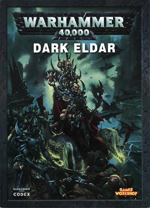 authors: Phil Kelly
authors: Phil Kelly
interior artists: John Blanche et al.
cover artist: uncredited
publisher: Games Workshop
publication date: 2010
cover: softcover
number of pages: 96
ISBN-10: 1-84154-978-9
ISBN-13: 978-1-84154-978-1
description: This book contains a complete description of the units in the Dark Eldar army. This book is compatible with the Warhammer 40,000 Role Playing Game.
Our featured entry from this bestiary is Lelith Hesperax, Mistress of the Cult of Strife.
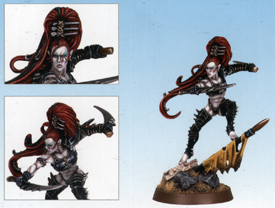 Lelith is the undisputed champion of the gladiatorial arenas. Most deadly of all her kind, Lelith's skill in the arts of combat bear all the hallmarks of true genius. Lelith is grace embodied, her movements hypnotic, sensual and spellbinding - watching Lelith go about her blood-soaked business is a privilege that only the wealthiest Dark Eldar can afford. To see such a superbly talented Succubus perform first-hand is a dream come true for most Kabalites, for it energises and reinvigorates even the eldest of their kind.
Lelith is the undisputed champion of the gladiatorial arenas. Most deadly of all her kind, Lelith's skill in the arts of combat bear all the hallmarks of true genius. Lelith is grace embodied, her movements hypnotic, sensual and spellbinding - watching Lelith go about her blood-soaked business is a privilege that only the wealthiest Dark Eldar can afford. To see such a superbly talented Succubus perform first-hand is a dream come true for most Kabalites, for it energises and reinvigorates even the eldest of their kind.
Though the purr of her voice has been likened to honeyed velvet, Lelith rarely speaks, for she is an artiste, not a politician. Nonetheless, her pronouncements are always carried out to the letter by her handmaidens, the Cult of Strife, who look in jealous awe at their mistress's flawless form and supernatural physical dexterity. On the eve before a realspace raid, Lelith will often pad like a hunting-cat into the halls of an Archon preparing for battle, flanked by dozens of hand-picked Wych acolytes. Lady Hesperax blesses raiding Kabals with her presence in this manner only in order to search out unusual prey; she loves to match her abilities against the most formidable elites and champions in the galaxy. She has yet to return without blood upon her blades and a new clutch of grisly trophies for her private museums.
Alone amongst the Wych Cults, Lelith does not use combat drugs to enhance her performance. Lelith's disciples, the Cult of Strife, maintain that their mistress needs nothing more than a piece of edged steel to outclass her foes. Sure enough, although she is expert in the use of all the exotic weapons used by her kind, Lelith can most frequently be seen fighting with two simple but perfectly weighted knives.
The harpies of the rival Wych cults whisper that Lelith's incredible skill is from an unnatural source - that she has somehow persuaded the Haemonculi to replace her blood with hyperdrenaline, that as a child she suckled upon a steroid-syringe, that she sleeps in a baryonic sarcophagus filled to the brim with stimulant serum. The truth is far simpler - like all born predators, Lelith prefers to fight up close. The use of combat drugs is for the weak, for they corrupt the instant where the killing strike hits home and the lifeblood flows out. How can one properly appreciate the delicate nuances of a victim's dying breath when one's senses are polluted by intoxicants? To forsake such chemical enhancement is usually suicidal in the lightning-fast world of the arena, yet such is Lelith's skill that her pristine flesh remains unscarred.
In battle, Lelith uses her body as a weapon as well as her blades. Her mane of silky hair is sewn through with barbs and hooks that she uses to snare the blades of her foes much in the manner of the shardnets of the Yraqnae. Her long legs and bare feet are edged with spurs, the better to tear open a throat with a perfect pirouette kick, and her fingernails have been reinforced and honed to scalpel sharpness. Lelith can kill a dozen lesser warriors in the space of a few seconds, her blades tracing a spiralling path between each fatal slash, before finishing with flourish and poise. Indeed, vid-steals of her doing so are traded throughout Commorragh and beyond by those with a twisted taste for violence. Perhaps, her spectators say, it is not only mortals who gaze with rapt attention as Lelith weaves her deadly dance.
|
|
|
|
|
May 25, 2019
Warhammer 40,000 Necrons
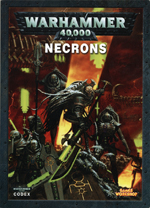 author: Matthew Ward
author: Matthew Ward
interior artists: John Blanche et al.
cover artist: uncredited
publisher: Games Workshop
publication date: 2011
cover: softcover
number of pages: 96
ISBN-10: 1-907964-18-5
ISBN-13: 978-1-907964-18-3
description: This book contains a complete description of the units in the Necron army. This book is compatible with the Warhammer 40,000 Role Playing Game.
Our featured entry from this bestiary is the Necron Immortal.
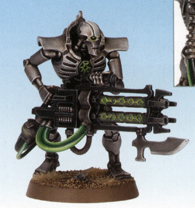 When the Necrons first conquered the galaxy, they did so through the unfaltering and implacable onslaught of legion upon legion of Immortals. These were the very elite of the Necrontyr armies, hardened veterans born anew in tireless metal bodies. For hundreds of years, the immortals were a scourge upon all who stood between the Necrons and galactic domination. Now, the Immortal legions are but an echo of what they once were, for countless trillions were destroyed in the final days of the War in Heaven. Yet billions more survived, and now wait only to be awakened from their
tombs and begin the reconquest of the galaxy.
When the Necrons first conquered the galaxy, they did so through the unfaltering and implacable onslaught of legion upon legion of Immortals. These were the very elite of the Necrontyr armies, hardened veterans born anew in tireless metal bodies. For hundreds of years, the immortals were a scourge upon all who stood between the Necrons and galactic domination. Now, the Immortal legions are but an echo of what they once were, for countless trillions were destroyed in the final days of the War in Heaven. Yet billions more survived, and now wait only to be awakened from their
tombs and begin the reconquest of the galaxy.
As the shock troops of a Tomb World's armies, immortals have a far wider range and depth of reaction than Necron Warriors, for they have retained much of their tactical and strategic experience. Indeed, in many ways the transfer to machine bodies and minds only sharpened the Immortals' ability to prosecute war in an efficient fashion. Left to their own devices, a phalanx of immortals continues to strive for victory using every tactic and stratagem at their disposal. This is not to say that immortals do not have shortcomings. Most profound is the fact that they are incapable of learning and adapting to new means of battle. On the rare occasions when immortals are presented with a battlefield situation that cannot be conquered by ancient tactics, they will apply the counter strategy they consider the closest match, regardless of its ultimate suitability. Fortunately, such instances are unusual for, no matter the advances in technology, war has changed little since the days of the War in Heaven.
|
|
|
|
|
June 1, 2019
Warhammer 40,000 Codex: Orks
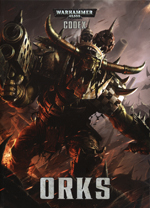 authors: uncredited
authors: uncredited
interior artists: uncredited
cover artist: uncredited
publisher: Games Workshop
publication date: 2014
cover: softcover
number of pages: 106
ISBN-10: 1-78581-173-8
ISBN-13: 978-1-78581-173-9
description: This book contains a complete description of the units in an Ork army. This book is compatible with the Warhammer 40,000 Role Playing Game.
Our featured entry from this bestiary is the gorkanaut.
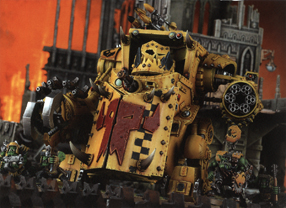 A Gorkanaut is everything an Ork aspires to be. Massive, tough, loud and destructive, its blocky silhouette loom menacingly over friend and foe alike. From its hulking, orkoid shape to the brutal weapons it wields, a Gorkanaut epitomises the unsubtle brutality of Cork and his no-nonsense way of war. Every Gorkanaut is essentially a massively overbuilt armoured war suit bristling with dakka and packing an armoured claw the size of a Killa Kan. They are ideal for a lone Nob who wants to make a name for himself; serving as weapon, transport and (rather cramped and smelly) home all in one. Gorkanauts have become especially popular in recent years as more greenskins are seized by visions of the Great Waaagh! and find themselves compelled to pilot these mighty engines into battle, trampling their panicked foes as they go.
A Gorkanaut is everything an Ork aspires to be. Massive, tough, loud and destructive, its blocky silhouette loom menacingly over friend and foe alike. From its hulking, orkoid shape to the brutal weapons it wields, a Gorkanaut epitomises the unsubtle brutality of Cork and his no-nonsense way of war. Every Gorkanaut is essentially a massively overbuilt armoured war suit bristling with dakka and packing an armoured claw the size of a Killa Kan. They are ideal for a lone Nob who wants to make a name for himself; serving as weapon, transport and (rather cramped and smelly) home all in one. Gorkanauts have become especially popular in recent years as more greenskins are seized by visions of the Great Waaagh! and find themselves compelled to pilot these mighty engines into battle, trampling their panicked foes as they go.
|
|
|
|
|
June 8, 2019
Warhammer 40,000 Chaos Daemons
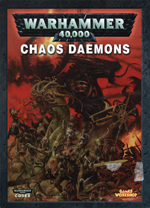 authors: Alessio Cavatore & Gav Thorpe
authors: Alessio Cavatore & Gav Thorpe
interior artists: John Blanche et al.
cover artist: Adrian Smith
publisher: Games Workshop
publication date: 2007
cover: softcover
number of pages: 88
ISBN-10: 1-84154-879-0
ISBN-13: 978-1-84154-879-1
description: This book contains a complete description of the units in an Chaos Daemon army. This book is compatible with the Warhammer 40,000 Role Playing Game.
Our featured entry from this bestiary is the soul grinder, iron doomstrider of chaos.
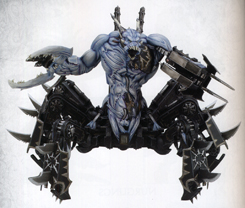 In the Formless Wastes of the Realm of Chaos there is a place that is perpetually cloaked in a pall of black, oily fumes, rank with the acrid stench of forbidden metallurgy, dominated by a cacophony of strident grinding and the wailing of uncountable tortured spirits. This accursed place is known as the Forge of Souls, where the blind, ever-mutating Daemon craftsmen of Chaos eternally hammer at their creations in cyclopean smitheries.
In the Formless Wastes of the Realm of Chaos there is a place that is perpetually cloaked in a pall of black, oily fumes, rank with the acrid stench of forbidden metallurgy, dominated by a cacophony of strident grinding and the wailing of uncountable tortured spirits. This accursed place is known as the Forge of Souls, where the blind, ever-mutating Daemon craftsmen of Chaos eternally hammer at their creations in cyclopean smitheries.
The black fires of these cavernous laboratories are fueled by the souls of the damned and kept roaring by colossal screaming bellows, manned by legions of semi-sentient nightmare creatures. From the dark bowels of the Forge of Souls come all manner of hideous and unholy weapons. By means of the perverse technologies of the artisans of Chaos, daemonic energies are fused with arcane metals to create great jagged blades, weeping swords, barbed steel whips and other potent weapons and talismans, to be used by the Daemons in their eternal warfare.
But as lethal as such weapons are, they are mere toys next to the greatest construct of the daemonic smiths - the dreaded Soul Grinders. These terrifying creatures are the fusion of the most powerful of daemonic entities with machines of war that originate from outside the Immaterium, but already have felt the touch of Chaos. These are often the wrecked remains of great Daemon engines and other possessed vehicles, like the mighty Battle Titans of the Legio Mortis, or the rampaging Defilers created by the Traitor Legions. All this ruined materiel is absorbed into the Warp as the flotsam and jetsam of a galaxy at war, flowing from real space into the lmmaterium through the Eye of Terror, the Maelstrom and the other loci where different realities touch.
In the ash plains outside the Forge of Souls battle never stops, as many amongst the higher ranks of Daemonhood vie with each other and duel for the chance of being the one to fuse with the mechanical constructs and become a Soul Grinder. This is because, unlike a possessed mortal body, these steel and ceramite shells can sustain a Daemon in the mortal world for decades, even centuries. During this time, the shape of each Soul Grinder will change, as their metal body slowly becomes more similar to the Daemon possessing it...
|
|
|
|
|
June 15, 2019
Warhammer Old World Bestiary
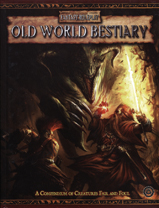 authors: T.S. Luikart & Ian Sturrock
authors: T.S. Luikart & Ian Sturrock
interior artists: Kori Christensen et al.
cover artist: Christer Sveen
publisher: Black Industries/Green Ronin Publishing
publication date: 2005
cover: hardcover
number of pages: 128
ISBN-10: 1-84416-226-5
ISBN-13: 978-1-84416-226-0
description: This book contains descriptions of the common and uncommon creatures of the Old World. This book is compatible with the Warhammer Fantasy Role Playing Game.
Our featured entry from this bestiary is the rat ogre.
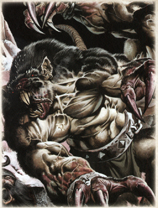 While the Moulder clan certainly succeeded in creating deadly war beasts, Rat Ogres are arguably flawed creatures, bereft of reason and nearly devoid of sanity. Their unlikely genesis has left them utterly dependent upon their creators for any kind of mental faculty and they are literally incapable of functioning without the direction of another's will. Without a handler to direct their efforts, they operate entirely on instinct, which varies radically from creature to creature. Whereas one may proceed to tear into nearby foes another may begin to ceaselessly drool, or lay down for a nap. Whatever shreds of intelligence that any given Rat Ogre managed to retain from birth will most certainly have been destroyed by the endless tests that the Moulder perform on the beasts. They are regularly subject to radical surgical experiments using Warpstone, which frequently involve amputation, vaguely directed mutations, unnatural grafts of flesh, and the implantation of metal plates or blades. Young Rat Ogres are continually forced to fight in "survival of the fittest" style contests where several are tossed into a pit, with only the last one alive being allowed to leave. Rat Ogres near inability to function without a Moulder handler present is widely suspected, by the other clans and the few scholars with knowledge of such things, to not be an accident. If they were ever to rebel against Clan Moulder, the results would be devastating.
While the Moulder clan certainly succeeded in creating deadly war beasts, Rat Ogres are arguably flawed creatures, bereft of reason and nearly devoid of sanity. Their unlikely genesis has left them utterly dependent upon their creators for any kind of mental faculty and they are literally incapable of functioning without the direction of another's will. Without a handler to direct their efforts, they operate entirely on instinct, which varies radically from creature to creature. Whereas one may proceed to tear into nearby foes another may begin to ceaselessly drool, or lay down for a nap. Whatever shreds of intelligence that any given Rat Ogre managed to retain from birth will most certainly have been destroyed by the endless tests that the Moulder perform on the beasts. They are regularly subject to radical surgical experiments using Warpstone, which frequently involve amputation, vaguely directed mutations, unnatural grafts of flesh, and the implantation of metal plates or blades. Young Rat Ogres are continually forced to fight in "survival of the fittest" style contests where several are tossed into a pit, with only the last one alive being allowed to leave. Rat Ogres near inability to function without a Moulder handler present is widely suspected, by the other clans and the few scholars with knowledge of such things, to not be an accident. If they were ever to rebel against Clan Moulder, the results would be devastating.
|
|
|
|
|
June 22, 2019
The Koronus Bestiary
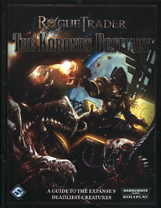 lead developers: Tim Huckelbery & Sam Stewart
lead developers: Tim Huckelbery & Sam Stewart
authors: Owen Barnes et al.
interior artists: Erfian Asafat et al.
cover artist: Daarken
publisher: Fantasy Flight Games/Games Workshop
publication date: 2012
cover: hardcover
number of pages: 144
ISBN-10: 1-58994-801-7
ISBN-13: 978-1-58994-801-3
catalog number: RT11
description: This book contains all manner of deadly beasts, hostile xenos, unholy daemons, and other dangers that fill the uncharted regions of the Koronus Expanse. This book is compatible with the Warhammer 40,000/Rogue Trader Role Playing Game.
Our featured entry from this bestiary is the void kraken.
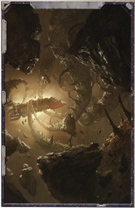 The physiology and nature of the Void Kraken are largely unknown, even to the most well-travelled Explorers of the Expanse. This is doubtless the result of their rarity and difficulty to hunt and detect, but could also be that they represent more than a single species of void behemoth, several variations on the beast mistakenly considered a single race of creatures. Whatever the truth of the Void Kraken's origins, a number of facts are largely agreed upon by those who have come into contact with them. They are almost certainly some form of silicon-based creature, without blood, true bone, or fluid to keep them alive. Instead, it is believed by those few adepts to consider the beasts that the Void Kraken draw their animus from the very space debris they often resemble.
The physiology and nature of the Void Kraken are largely unknown, even to the most well-travelled Explorers of the Expanse. This is doubtless the result of their rarity and difficulty to hunt and detect, but could also be that they represent more than a single species of void behemoth, several variations on the beast mistakenly considered a single race of creatures. Whatever the truth of the Void Kraken's origins, a number of facts are largely agreed upon by those who have come into contact with them. They are almost certainly some form of silicon-based creature, without blood, true bone, or fluid to keep them alive. Instead, it is believed by those few adepts to consider the beasts that the Void Kraken draw their animus from the very space debris they often resemble.
Kraken appear to be solitary, asexual creatures that reproduce by dividing themselves, much in the same fashion as amoebas or single-celled organisms. A Kraken tears off a piece of itself and flings it at a world (ideally airless and devoid of life) to create a hatchling which then burrows into the surface of the planetoid, feeding off the rock for decades or even centuries before emerging as a fledgling Kraken and flinging itself into space to hunt (another reason for choosing small asteroids or rocks with little gravity to overcome for the young). There is speculation that Kraken might mate, and some process of fertilisation is required for these hatchlings, but so far there has been no proof, or conceivable way to tell a male Kraken from a female Kraken, if such things do indeed exist.
Void Kraken feed off minerals found in rock, which explains their interest in ships. The hulls of most void-worthy vessels present a Kraken with a concentrated collection of metals, ores, and silicates for it to feed on, a tempting and tasty morsel for the beast. Small ships have the most to fear from the Kraken, as the beast's size and strength, especially when striking from ambush in an asteroid field or close to a world, can quickly overpower a ship and render it helpless to fight back. Even larger vessels are not immune, however, and Void Kraken attack things many times their own size, latching onto them like a limpet mine. Only ship-borne weaponry is any defence against a Kraken, and only then if the vessel detects the Kraken early enough and manages to drive it off with broadsides or lance strikes.
Once a Kraken has entangled a ship, it only disengages when the ship has been consumed or (if the ship is much larger than the Kraken) once it has taken a substantial bite from its hull. This process of consumption is as ponderous as the Kraken itself, however, and it is possible for a particularly brave crew to venture out onto the hide of the beast while it is feeding and lay mines on it or try and cut away its tentacles. Such a task is fraught with danger and the Kraken often reacts quickly to such "parasites" on its hide by throwing up small fanged tentacles to rake back and forth, scouring its stony flesh clean. Sometimes a Kraken declines to consume a ship straight away, or, if it has fed enough on its hull, it may leave the wreck alone. In these cases, Kraken have been known to drag lifeless ships from one system to another, gathering the hulks around remote worlds or in deep space, possibly to feed on at a later time.
|
|
|
|
|
June 29, 2019
Fantasy Age Bestiary
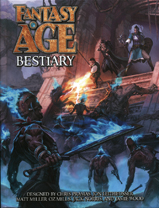 development: Jack Norris
development: Jack Norris
authors: Chris Pramas, Jon Leitheusser, Matt Miller, Oz Mills, Jack Norris & Jamie Wood
interior artists: Victor Corbella et al.
cover artist: Diego Gisbert Llorens
publisher: Green Ronin Publishing
publication date: 2016
cover: hardcover
number of pages: 140
ISBN-10: 1-934547-73-5
ISBN-13: 978-1-934547-73-1
catalog number: GRR6004
description: This book contains more than 50 monsters as well as animals. This book is compatible with the AGE (Adventure Game Engine) Role Playing System.
Our featured entry from this bestiary is the zenadrim.
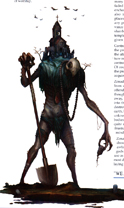 Zenadrim are ancient giants who once thought themselves so powerful that they believed they could battle death itself, making themselves immortal. For their arrogance, the gods punished them. They enslaved the giants, working them nearly to death building ancient monuments to their captors.
Zenadrim are ancient giants who once thought themselves so powerful that they believed they could battle death itself, making themselves immortal. For their arrogance, the gods punished them. They enslaved the giants, working them nearly to death building ancient monuments to their captors.
When one of the giants was finally near death from their endless toil, the gods would finally grant the giant a conditional immortality, trapping its spirit inside its half-dead body. They then had the giants bury themselves alive and bound them to the earth. On each spot where a giant fell, priests were directed to build temples, shrines, chapels, and other places of worship.
To force them to serve even in this half-dead state, the gods bound each giant to an ancient relic, usually crafted from the skull or bones of a great hero or saint - the only thing which could awaken and control the giants. They would occasionally give these relics to their faithful, who used them to battle terrible demons or other threats, punish heretical sects, and carry out other large scale acts of destruction in the name of their gods. The giants were known by many names: zenadrim (the name the giants gave themselves when living), grave giants, shrine titans, mound colossus, and more.
Over time, the world changed. Most of the civilizations and many of the faiths which knew the secrets of these creatures faded into history. However, the giants remained, and the enchantments which bound them in servitude and slumber also influenced the lands where they slept. Their resting places would grow no crops and thoughts to use the land for any purpose other than worship, burial, or religious observance faded as soon as they materialized. Thus the zenadrim slumbered for millennia, trapped under shrines, churches, temples, and other holy sites, waiting to be awakened and given purpose.
|
|
|
|
|
July 6, 2019
Ars Magica Medieval Bestiary
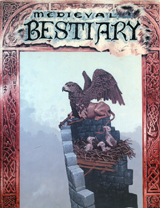 authors: Tim Carroll and Ken Cliffe
authors: Tim Carroll and Ken Cliffe
interior artists: Tony Ackland, Eric Hotz & David Transue
cover artist: Michael Weaver
publisher: White Wolf
publication date: 1991
cover: softcover
number of pages: 128
ISBN-10: 1-56504-009-0
ISBN-13: 978-1-56504-009-0
catalog number: WW 1017
description: This book contains descriptions of over 100 beasts of both legend and the mundane world. This book is compatible with the Ars Magica Role Playing Game.
Our featured entry from this bestiary is the dodo.
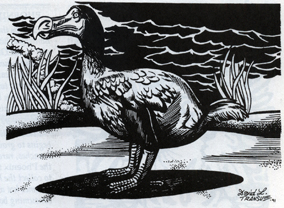 DIDUS INEPTUS, the dodo
DIDUS INEPTUS, the dodo
Didus has a huge, clumsy body and small, ineffectual wings. Even running, it is slow, and except to feed, rarely does it bother to move at all. The Dodo is nature's warning to man: in fattened lassitude the gifts of life lie dormant. Because of its gluttony and its lack of industry, Didus cannot fly, as it was clearly intended to do. Because it is slothfulness, trusting, and indifference, the Dodo waits to be slaughtered. Woe to those who would only take what magic gives! Woe to those who trust blindly! Woe to those who are uncareful, uncaring!
|
|
|
|
|
July 13, 2019
Magnamund Bestiary
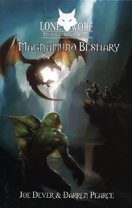 authors: Joe Dever & Darren Pearce
authors: Joe Dever & Darren Pearce
interior artist: Rich Longmore
cover artist: Ben Ellebracht
publisher: Mongoose Publishing
publication date: 2011
cover: softcover
number of pages: 200
ISBN-10: 1-907218-90-4
ISBN-13: 978-1-907218-90-3
catalog number: MGP 1318
description: This book contains a collection of animals, humanoids, undead, constructs and other classes of creatures. This book is compatible with the Lone Wolf Role Playing Game.
Our featured entry from this bestiary is the plaak.
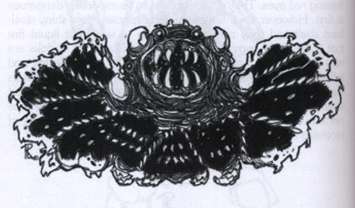
*Editor's note: Extensive pixelation of this image is not due to the scanning but is rather common to all images in the book, a result of the chosen printing process.
|
Physical Description: Plaak resemble grey, jelly-like discs with two sets of snake-like fangs that ooze sticky yellow venom. They are capable of adhering to any hard surface.
History: Plaak are living instruments of assassination favoured by the Liganim and Nadziranim. They were created by the Nadziranim who served Darklord Vashna and first appeared in Helgedad at the same time as the Mountain Giaks.
Combat: Plaak can remain inert for long periods of time. When they activate, they move with breathtaking speed and can be very hard to predict and hit in a combat situation. Their jelly-like bodies are very rubbery, which enables them to bounce off hard services and assault an adversary from myriad angles and aspects.
|
|
|
|
|
July 20, 2019
The Art of Overwatch
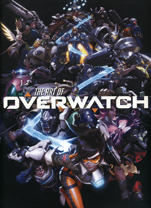 writer: Matt Burns
writer: Matt Burns
designer: David Nestelle
artists: Arnold Tsang et al.
digital art technicians: Christina McKenzie et al.
publisher: Dark Horse Books
publication date: 2017
cover: hardcover
number of pages: 368
ISBN-10: 1-5067-0367-4
ISBN-13: 978-1-50670-367-1
description: This book contains a gallery of art from the Overwatch video game. This book is compatible with the Overwatch video game, developed by Blizzard Entertainment. Relevant to this survey of bestiaries, the Heroes chapter, running from page 013 to 132, which contains textual and graphic descriptions of twenty-four heroes.
Our featured entry from this bestiary is D.Va.
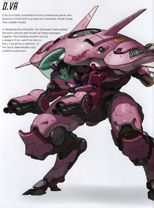 D.Va is a highly competitive former professional gamer who became a mech pilot to protect her homeland, South Korea, from outside threats.
D.Va is a highly competitive former professional gamer who became a mech pilot to protect her homeland, South Korea, from outside threats.
In designing this character, the Overwatch team wanted the mech and pilot to feel as if they belonged together. The machine wouldn't just be a weapon D.Va used from time to time; it would be a reflection of her fierce determination and youthful exuberance.
 Decal Designs--Once the Overwatch team fleshed out D.Va's backstory as a professional gamer, concept illustrations began reflecting that in the form of sponsorship decals.
Decal Designs--Once the Overwatch team fleshed out D.Va's backstory as a professional gamer, concept illustrations began reflecting that in the form of sponsorship decals.
Early Concepts--Some of the concepts for D.Va featured a pilot who was much younger than the final version. The game team wanted the character to be older and more intimidating, so they increased her age and adjusted the mech to feel more threatening.
These illustrations also featured a cat logo on her suit and mech. The design was later changed to a bunny, which seemed like a better fit for D.Va's ability to fly--or "hop"--short distances.
|
|
|
|
|
July 27, 2019
The Creature Companion
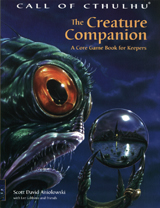 authors: Scott David Aniolowski with Lee Gibbons and friends
authors: Scott David Aniolowski with Lee Gibbons and friends
interior artists: Paul Carrick, Earl Geier & Rodell Sanford
cover artist: Lee Gibbons
publisher: Chaosium Inc.
publication date: 1998
cover: softcover
number of pages: 112
ISBN-10: 1-56882-133-6
ISBN-13: 978-1-56882-133-7
catalog number: 2375
description: This book contains a compendium of creatures, including Outer Gods, Elder Gods, Great Old Ones, Avatars, Servitor Races, all malevolent or uncaring. This book is compatible with the Call of Cthulhu Role Playing Game.
Our featured entry from this bestiary is the spawn of Hastur.
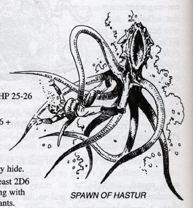 Spawn of Hastur, Greater Servitor Race. Amid the Hyades / We reached at last that bleak and mythic world / To men forbidden and by gods abhorred, / Carcosa, where the great Hastur is Lord.-Lin Carter, "Dreams from R'lyeh".
Spawn of Hastur, Greater Servitor Race. Amid the Hyades / We reached at last that bleak and mythic world / To men forbidden and by gods abhorred, / Carcosa, where the great Hastur is Lord.-Lin Carter, "Dreams from R'lyeh".
Like their sire, the spawn of Hastur are never clearly described except to say that they are octopoidal and have unspeakably hideous faces. Some references erroneously suggest that the spawn of Hastur are identical to those of Cthulhu, the star-spawn. Although they may have certain similarities, the spawn of Cthulhu and Hastur are not similar races.
The spawn of Hastur are aquatic, or at least amphibious, as they are only ever mentioned as appearing with the Unspeakable One in the foul and murky lake of Hali. The spawn do have limited flight capabilities and may make short excursions over land.
Like their master, these beings may be summoned
to Earth only when Aldebaran is above the horizon.
|
|
|
|
|
August 3, 2019
Bestiary of the Hyborian Age
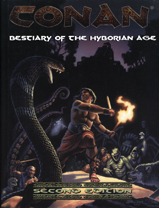 authors: Bryan Steele e& Laszlo Cook
authors: Bryan Steele e& Laszlo Cook
interior artists: Robin Bowles et al.
cover artist: Chris Quilliams
publisher: Mongoose Publishing
publication date: 2008
cover: hardcover
number of pages: 176
ISBN-10: 1-905850-11-5
ISBN-13: 978-1-905850-11-2
catalog number: MGP 7803
description: This book contains over 100 beasts and other entities. This book is compatible with the Conan: The Hyborian Age Role Playing Game.
Our featured entry from this bestiary is the brylukas, a bat demon.
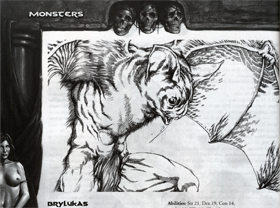 A creature pulled from Zaporoskan legend, the brylukas is a spindly demon that bears the features of a man, beast and bat. They exist solely to destroy and soar the night on wings of black leather from the place of their summoning to the target of their rage. When the bat-demons have been placed upon the trail of their prey, or the prey of their summoner, nothing will stand in their way.
A creature pulled from Zaporoskan legend, the brylukas is a spindly demon that bears the features of a man, beast and bat. They exist solely to destroy and soar the night on wings of black leather from the place of their summoning to the target of their rage. When the bat-demons have been placed upon the trail of their prey, or the prey of their summoner, nothing will stand in their way.
Brylukas are slightly smaller than a man in height, but have thin and leathery wings that stretch wide behind them. Their faces are a twist of bat and mannish features, with long and savage teeth in their jaws, glowing red eyes and fringed ears. Their sinewy bodies are covered in greasy thin fur, and their blood is as black and thick as tar.
A brylukas can be summoned with a summon demon spell, especially if the sorcerer plans on placing it in a demonic pact. Without the pact, a bat-demon will nearly always attack anything that gets in its path as it flies from place to place according to its own unfathomable whims--possibly including the sorcerer who summoned it!
|
|
|
|
|
August 10, 2019
A Field Guide to Fantastical Beasts
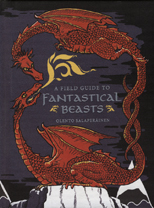 author: Olento Salaperäinen
author: Olento Salaperäinen
interior artist: Andrew Pinder
cover artist: Andrew Pinder
publisher: Metro Books / Quantum Books
publication date: 2016
cover: hardcover
number of pages: 192
ISBN-10: 1-4351-6318-4
ISBN-13: 978-1-4351-6318-8
description: This book is an atlas of fifty fabulous creatures, enchanted beings and magical monsters.
Our featured entry from this bestiary is the pixie.
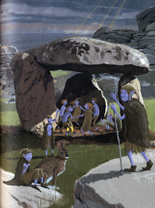 Pixies (or piskies or even pigsies) are a species of fairy-like creatures native to Devon and Cornwall in the South West of England. Like fairies they are small, nimble, and generally full of joy, although they lack the wings and elegance of their fairy comrades. They tend to be red-haired with pointed ears, wearing green rags and pointed hats. Above all, pixies love to play, and will contrive spurious reasons to put on a colorful carnival or even lure human children to join them in a dizzying dance. They are particularly partial to horse riding, and have been known to steal horses and ride them round and round in wild circles. Pixies are usually kind to humans, although their relentless form of mindless mischief has occasionally led to clashes.
Pixies (or piskies or even pigsies) are a species of fairy-like creatures native to Devon and Cornwall in the South West of England. Like fairies they are small, nimble, and generally full of joy, although they lack the wings and elegance of their fairy comrades. They tend to be red-haired with pointed ears, wearing green rags and pointed hats. Above all, pixies love to play, and will contrive spurious reasons to put on a colorful carnival or even lure human children to join them in a dizzying dance. They are particularly partial to horse riding, and have been known to steal horses and ride them round and round in wild circles. Pixies are usually kind to humans, although their relentless form of mindless mischief has occasionally led to clashes.
THE PIXIE REVENGE
While pixies are believed to predate Christianity in Britain, their precise origin is unknown, but what is certain is that they are not fond of organized religion. The Devon town of Ottery St Mary, to this day, prides itself on having successfully chased out its pixie nemeses on Midsummer's Eve 1454, following 800 years of anarchic mayhem. When the bells of the parish church rang out for the first time on that day, the pixies fled in terror-only to return and abduct the town's bell-ringers. An annual midsummer festival known as Pixie Day now commemorates the "Pixie Revenge," and the streets of Ottery St Mary are filled with children dressed as pixies, who chase the bell-ringers out of town before welcoming them back with great fanfare.
|
|
|
|
|
August 17, 2019
Alien Bestiary
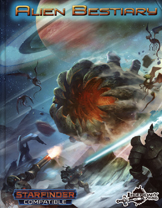 lead designer: Jason Nelson
lead designer: Jason Nelson
interior artists: Hanyo Arte et al.
cover artist: uncredited
publisher: Legendary Games
publication date: 2018
cover: hardcover
number of pages: 448
ISBN-10: 0-9861035-7-8
ISBN-13: 978-0-9861035-7-5
catalog number: LGP400AB01SF
description: This book contains nearly 300 monsters, playable races and creatures of the Aethera system. This book is compatible with the Starfinder Role Playing Game.
Our featured entry from this bestiary is the living nebula.
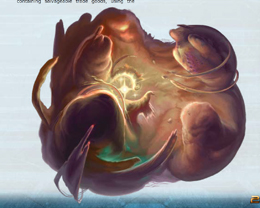 Living nebulas are fragments of awakened cosmic
consciousness that have coalesced over long
centuries and have drawn accretions of dust and
gas into themselves to surround their living spark,
infusing the dust with their awareness like plankton
floating on the eddies of the interstellar ocean.
They frequently inhabit nebulas but also rove the
spaceways, with an uncanny ability to sense the
presence of starships and trail along behind them
absorbing waste energies from their engines.
Living nebulas are fragments of awakened cosmic
consciousness that have coalesced over long
centuries and have drawn accretions of dust and
gas into themselves to surround their living spark,
infusing the dust with their awareness like plankton
floating on the eddies of the interstellar ocean.
They frequently inhabit nebulas but also rove the
spaceways, with an uncanny ability to sense the
presence of starships and trail along behind them
absorbing waste energies from their engines.
These composite creatures are playful, with
an almost childlike immaturity of children and a
curiosity about travellers in the void combined with
an alien lack of awareness about the repercussions
of their actions. Most instances of their “attacks”
against space travellers are more a result of them
getting too close to the objects of their interest
and unintentionally damaging creatures or their
vessels, or playful illusory pranks created in a
misguided effort to communicate with travellers
or get them to chase, play tag, or other juvenile
forms of recreation. A pod of living nebulas might
pretend to be an asteroid field, using holographic
terrain and holographic image to enhance the
effect. A lone living nebula may take up residence
within the abandoned hulk of a derelict starship
containing salvageable trade goods, using the
interior ventilation ducts of the vessel to facilitate
its movement. Explorers may not realize a living
nebula is behind the strange happenings occurring
around them until the creature reveals itself.
|
|
|
|
|
August 24, 2019
Book of Adria: A Diablo Bestiary
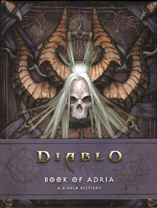 authors: Robert Brooks & Matt Burns
authors: Robert Brooks & Matt Burns
interior artists: Josh Tallman et al.
cover artist: Christian Lichtner
publisher: Blizzard Entertainment
publication date: 2018
cover: hardcover
number of pages: 144
ISBN-10: 1-945683-20-1
ISBN-13: 978-1-945683-20-6
description: This book contains dozens of demons, beasts, risen dead and angels of the Diablo multiverse.
Our featured entry from this bestiary is Andariel, the Maiden of Anguish.
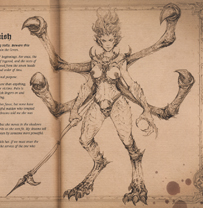 Now I write of the seven Lords of the Burning Hells. Beware this knowledge for it is dark and forbidden, even within the Coven.
Now I write of the seven Lords of the Burning Hells. Beware this knowledge for it is dark and forbidden, even within the Coven.
I know what the scholars say of the demon lords' beginnings. For once, the secret histories of the Vizjerei, the sealed tomes of lvgorod, and the texts of the old Triune agree: each of the Evils were spawned from the seven heads of Tathamet, the first being to challenge the eternal order of Anu.
I do not care of their ancient origins, only their final purpose.
Andariel is a frightening creature. She desires, more than anything, to inflict horrors that crack open the minds of her victims. Pain is her tool, not her end. Daggers can kill, but anguish lingers on and eats away at the mind, reducing its prey to nothing.
Others within the Coven have attempted to seek her favor, but none have ever been seen again. I once encountered a beautiful maiden who tempted
me with promises of power. The whispers in my dreams told me she was lying, so I refused.
Andariel is ambitious, cunning, and dangerous, but she moves in the shadows and latches onto the plans of the other demon lords as she sees fit. My dreams tell me that her fate will not be her own, but one chosen by someone more powerful.
I believe the Coven should never make treaty with her. If we must enter the service of the Burning Hells, we must do so in the service of the one who shall reign supreme.
|
|
|
|
|
August 31, 2019
Creature Catalogue
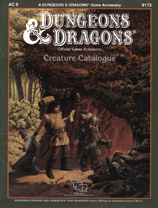 lead designers: Graeme Morris, Phil Gallagher & Jim Bambra
lead designers: Graeme Morris, Phil Gallagher & Jim Bambra
interior artists: Jeff Anderson et al.
cover artist: uncredited
publisher: TSR Inc.
publication date: 1986
cover: softcover
number of pages: 96
ISBN-10: 0-88038-315-1
ISBN-13: 978-0-88038-315-8
catalog number: AC 9
description: This book contains over 150 creatures, classified as animals, conjurations, humanoids, lowlifes, monsters and undead. This book is compatible with the first edition Dungeons & Dragons role playing game.
Our featured entry from this bestiary is the xytar.
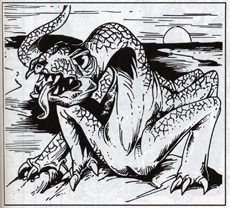 A Xytar is a large, 8-foot-long, lizard-like creature. Its hide is predominantly yellow, with red and orange mottling along its back. Xytars have six legs and long tooth filled jaws. They live in hot desert areas and can survive for weeks without water.
A Xytar is a large, 8-foot-long, lizard-like creature. Its hide is predominantly yellow, with red and orange mottling along its back. Xytars have six legs and long tooth filled jaws. They live in hot desert areas and can survive for weeks without water.
Xytars are carnivorous creatures who normally hunt in packs. Human or other settlements on the fringes of deserts are often attacked by hunting xytars, as are any caravans unlucky enough to run into them. There are usually no survivors from xytar attacks.
Xytars attack with either their strong jaws or by their breath weapon. They can breath forth a cone of fire 30 feet long and 10 feet wide at its widest point. They always attack by breathing fire first and then closing to use their jaws in melee. Once in melee there is a 1-2 chance on ld6 that a xytar will breath instead of biting its opponent.
Xytars are unaffected by normal fires and always make their Saving Throws against magical fires.
|
|
|
|
|
September 7, 2019
Nightmares & Dreams: A Creature Collection
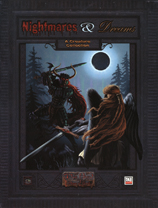 authors: Doug Herring, Andrew Thompson, Kenny Lewis & John Kubisz
authors: Doug Herring, Andrew Thompson, Kenny Lewis & John Kubisz
interior artists: Doug Herring et al.
cover artist: Dave Manuel
publisher: Mystic Eye Games
publication date: 2001
cover: softcover
number of pages: 72
ISBN-10: 0-9708265-2-4
ISBN-13: 978-0-9708265-2-7
catalog number: MYG0003
description: This book contains a menagerie of creatures and items that demonstrate the power of dreams and nightmares in other realms. This book is compatible with the d20 role playing system and is a core book for "The Hunt: Rise of Evil".
Our featured entry from this bestiary is the insomniux.
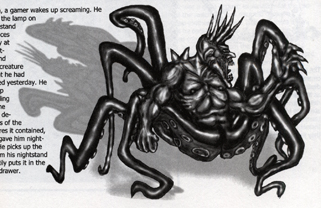 Even a quick glance will tell you this creature is a demon from the lowest reaches of the darkest abyss. Its massive head supports six titanic horns and a grizzly jaw filled with saber-like teeth. Fire burns in its cat-like eyes. The insomniux slithers about on eight strong tentacles, sometimes aided by his thick, muscular arms. The arms end in massive claws capable of rending through the toughest armor.
Even a quick glance will tell you this creature is a demon from the lowest reaches of the darkest abyss. Its massive head supports six titanic horns and a grizzly jaw filled with saber-like teeth. Fire burns in its cat-like eyes. The insomniux slithers about on eight strong tentacles, sometimes aided by his thick, muscular arms. The arms end in massive claws capable of rending through the toughest armor.
Insomniux demons have a sick sense of humor, and enjoy tricking their prey. Their favorite trick is to blur the difference between reality and a nightmare. Through its spell-like abilities and creative staging, this demon is a master of torment. By the time the insomniux actually physically attacks, its victims are usually worn out from running away from their own nightmares, and are often uncertain if they are dreaming or awake.
Nightmare/Dream: A spectacled man is up late reading in his study. He hears a quiet knock at his front door. Cautiously approaching the door, he asks, "Who is there?" No answer comes from behind the door. He peeks through the peephole and sees no one. Confused, the man turns to go back to his chair. Suddenly three explosive knocks shake the door with ferocity. The man jumps from fright. Once again, with concern in his voice, he asks, "Who, pray tell, is there?" Again there is no answer. The man, now nervous and quivering, weakly squeaks "This isn't funny. I am going to open the door, and you better be there." Afterwards, he picks up a small shovel from besides the fireplace for defense. He slowly sneaks toward the door, quietly undoes the latch, and flings the door wide open. Standing at the door is a hideous creature, a tentacled, monstrous thing, with its claws held wide and mouth open. The shovel drops from the man's hands as his world spins into darkness.
|
|
|
|
|
September 14, 2019
Colonial Gothic Bestiary
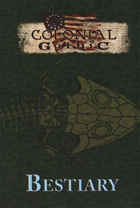 author: Richard Iorio II
author: Richard Iorio II
interior artists: Mikuláŝ Aleŝ et al.
cover artist: uncredited
publisher: Rogue Games/Chronicle City
publication date: 2013
cover: softcover
number of pages: 108
ISBN-10: 1-939299-22-5
ISBN-13: 978-1-939299-22-2
catalog number: RGG1667
description: This book contains over 50 creatures. This book is compatible with the Colonial Gothic role playing game.
Our featured entry from this bestiary is the revenant.
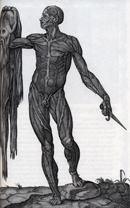 Infernal: This creature emits an aura of evil that requires all within 10 feet of it to make a Fear Test. Upon failing this Test, the person feels uncomfortable, as well as having a desire to get away as quickly as possible. They will flee for a number of rounds equal to the revenant's Resolution. Infernal creatures are immune to normal, weapons, but weapons that have been blessed by a religious figure cause them double damage.
Infernal: This creature emits an aura of evil that requires all within 10 feet of it to make a Fear Test. Upon failing this Test, the person feels uncomfortable, as well as having a desire to get away as quickly as possible. They will flee for a number of rounds equal to the revenant's Resolution. Infernal creatures are immune to normal, weapons, but weapons that have been blessed by a religious figure cause them double damage.
Taint: Taint fuels a revenant when it manifests in the physical world. It costs a revenant 1 Taint per minute to manifest. Taint also acts in place of Vitality: damage suffered is subtracted from a revenant's Taint score. When its Taint is reduced to 0, a revenant disappears from the physical world and cannot reappear for a number of days equal to its Resolution.
Weakness: Fire causes a revenant double damage; removing the heart of a revenant kills it instantly.
It is said that the most evil and violent of mortals will never rest easily in their graves. Whether by a pact with the Dark Powers or through their own strength of will, revenants rise again and again to terrorize the living.
|
|
|
|
|
September 21, 2019
Bestiary of Loerem
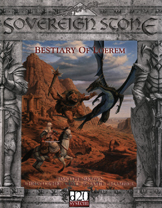 authors: Timothy Brown, Christopher Coyle & Jamie Chambers
authors: Timothy Brown, Christopher Coyle & Jamie Chambers
interior artists: Andy Hopp & Larry Elmore
cover artist: Larry Elmore & Stephen Daniele
publisher: Sovereign Press
publication date: 2002
cover: hardcover
number of pages: 224
ISBN-10: 1-931567-05-0
ISBN-13: 978-1-931567-05-3
catalog number: SVP-3003
description: This book contains 95 new creatures from the Sovereign Stone campaign setting. This book is compatible with the d20 role playing game system.
Our featured entry from this bestiary is the kaer.
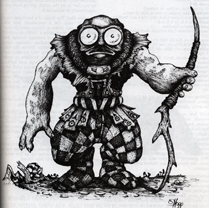 Kaer are fey of the elven forests who use their strange powers to snatch young children away from their families.
Kaer are fey of the elven forests who use their strange powers to snatch young children away from their families.
Kaer are so rarely seen that many elves do not believe in their existence, considering them the stuff of bedtime stories and nursery rhymes. In truth, these stories and rhymes were written in ancient days to teach children to avoid the kaer. It is not known why the kaer steal away children, though the stories always suggest the kaer eat them. The Wyred have long speculated that the children are somehow transformed into kaer, since this breed of fey has no other way to reproduce. The appearance of enormous groups of snails congregating in an area is said to either foretell their coming or indicate that a kaer has recently been in the area.
Kaer are hairless, distorted, disfigured humanoid creatures with misshapen, bloated features and large, unblinking eyes. Their skin is blotchy, ranging in from brown to grayish white. Lighter blotches of white and gray upon their arms and heads are said to be corrupt versions of elven family tattoos.
Kaer clothing is a chaotic mishmash of hide, cloth, leather, and bone whose colors are jarring to the eye. They cover their clothing with strange, undecipherable symbols and patterns that apparently have meaning to them. Each Kaer possesses a staff crafted from wood, stone, horn, hide, or bone.
Kaer are incapable of communication with other humanoids and perhaps not even with each other. They are able to move in almost complete silence through any terrain. They are adept at hiding, able to fool even many trained, watchful eyes. Some Kaer are adept at magic and possess levels of Air mage.
|
|
|
|
|
September 28, 2019
Hero Bestiary
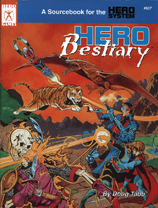 author: Doug Tabb
author: Doug Tabb
interior artists: Storn Cook et al.
cover artist: Storn Cook & Frank Cirocco
publisher: Hero Games/Iron Crown Enterprises
publication date: 1992
cover: softcover
number of pages: 192
ISBN-10: 1-55806-168-1
ISBN-13: 978-1-55806-168-2
catalog number: #507/ICE 1800
description: This book contains over 280 mythical monsters, dinosaurs and animals. This book is compatible with the Fantasty Hero and all other Hero System role playing game system.
Our featured entry from this bestiary is the pooka.
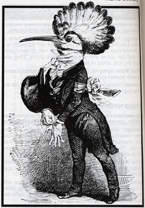 Appearance: Pookas are 10 inch tall creatures with human bodies and the heads of animals. They wear tiny replicas of human clothing.
Appearance: Pookas are 10 inch tall creatures with human bodies and the heads of animals. They wear tiny replicas of human clothing.
Ecology: Pookas are household fairies who seek to coexist peacefully with humans. They do not think of their condition so much as living in someone else's house but as sharing the house with someone else. They will not usually make themselves known to their "housemates" but will see to it that the house is kept up and protected. To this end Pookas have the ability to change into the shape of animals to scare away intruders or vandals. If the house's owner is aware of the Pooka and accommodates him, the Pooka might grant the person the ability to understand the language of animals.
Motivations: Pookas share motivations common with humans. They wish only to survive and go about their daily business, though they do enjoy the occasional prank.
Combat Techniques: Pookas are all bark and no bite. Though they can change into the shapes of animals they are not capable of doing much damage beyond the poorly placed punch or kick.
Other Names: Puca, Puka
Rumors: Evil Pookas exist who can not only assume the shape of animals but will have all those animal's abilities as well.
|
|
|
|
|
October 5, 2019
The Bygone Bestiary
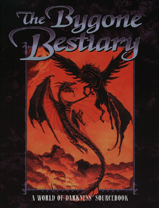 authors: Phil Brucato, Shanti Fader, Eric Griffin, Jess Heinig, Kenneth Hite, Sian Kingstone and Angel McCoy
authors: Phil Brucato, Shanti Fader, Eric Griffin, Jess Heinig, Kenneth Hite, Sian Kingstone and Angel McCoy
interior artists: Barbara Armata et al.
cover artist: Mark Jackson
publisher: White Wolf Publishing
publication date: 1998
cover: softcover
number of pages: 128
ISBN-10: 1-56504-491-6
ISBN-13: 978-1-56504-491-3
catalog number: WW 4802
description: This book contains dozens of creatures both magical and mundane from the World of Darkness campaign setting. This book is compatible with the Mage: The Sorcerers Crusade, Mage: The Ascension, Changeling: The Dreaming and Vampire: The Dark Ages role playing games.
Our featured entry from this bestiary is the peryton.
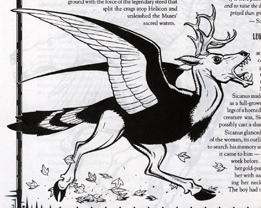 Description:
Murder leaves a scar on the soul. A person brutally cut down by the hand of another finds only frustration in the afterlife. Some murders occur with such suddenness that the victim's soul bellows for vengeance, refusing to move on until the person who inflicted the wrong is dead. The calls of these souls are heard and answered by the peryton.
Description:
Murder leaves a scar on the soul. A person brutally cut down by the hand of another finds only frustration in the afterlife. Some murders occur with such suddenness that the victim's soul bellows for vengeance, refusing to move on until the person who inflicted the wrong is dead. The calls of these souls are heard and answered by the peryton.
Tales of the lost city of Atlantis record the existence of perytons, creatures with the head and legs of a deer and the body and wings of a great bird of prey. Beautiful and lethal, these creatures were born from the chaos caused by the unjust severing of a person's lifeline. Intimately attuned to the anger and sorrow of a victim's soul, a peryton casts the shadow of the person in life as the creature hunts unceasingly for its charge's killer. When a peryton catches its target - and it always does - the end is savage and violent. On dispatching its prey, the peryton is released from its obligation and its shadow reverts to its own.
Perytons reside deep within forests or atop remote mountain plateaus. They subsist mainly on dry earth, but when they hear the anguished cry of the innocent, perytons can go for weeks (or even months) without food, fueling themselves with the fiery singlemindedness of vengeance. The creatures are experts at camouflage. Depending on the environment, a peryton can transform the deer or bird half of itself to match its surroundings.
A peryton speaks for the dead, and in a very specific, pointed manner. The creature acts as the vehicle for a murdered soul's revenge, and its most common interaction with human beings is as a harbinger of wrathful destruction. As a consequence, perytons view human beings warily at best, avoiding the great majority of human contact until a soul calls for service. Rarely is the interaction between a peryton and a human being uneventful. The few individuals who run across a peryton in its deer form on a trek through a forest (or, even more foolishly, on a hunting expedition) are lucky to survive.
Future Fate:
Perytons have decreased considerably since the days of the ancient Greeks. Downtrodden humanity has lost its spirit since the old times, and not even tragic deaths inspire a response from liberated souls anymore. Still, many acts of ultimate barbarity - particularly when the victim is an innocent such as a child, maiden or young lover - can create enough outrage to call forth a peryton. There is even rumor among those who feed on humans that something is out there taking revenge, though none can identify what the creature is.
Image:
The peryton is strangely compelling for such a lethal animal. Its deer's head has soft black, brown or gray fur. A set of full, saber-sharp antlers sits regally atop the creature's head, and is its main weapon. Two strong deer legs give the peryton unmatched speed on the ground. Its dark hooves have the capacity to shatter bone with a kick. Its avian body, with shadowy gray wings and plumage, allows the peryton to fly and dive with expert agility. The creature's doe-eyes, normally dark brown or jet-black, glow red with rage in the presence of its prey.
|
|
|
|
|
October 12, 2019
Boreal Bestiary
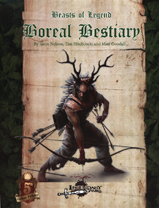 authors: Jason Nelson, Tim Hitchcock & Matt Goodall
authors: Jason Nelson, Tim Hitchcock & Matt Goodall
interior artists: Frank Hessefort, Jason Juta & Tanyaporn Sangsnit
cover artist: uncredited
publisher: Legendary Games
publication date: 2016
cover: softcover
number of pages: 40
ISBN-10: 1530972449
ISBN-13: 978-1530972449
catalog number: LG028KM055E
description: This book contains ten creatures for a northern wilderness campaign setting. This book is compatible with the 5th edition of the Dungeons & Dragons role playing game system.
Our featured entry from this bestiary is the wiitikowan raven.
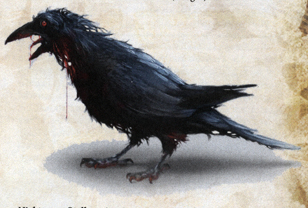 A wiitikowan is the result when a living creature is spiritually consumed by a raw and hungry spirit of nature. Most common in cold, harsh lands where humanity and its kin sometimes teeter on the edge of relapsing into savagery andaven cannibalism in order to survive, a wiitikowan may also arise as a result of a powerful curse. In any case, its appearance is wild yet haggard, its hair, fur, or feathers matted and its skin scarred and tattered (or, in rare cases, completely falling out and leaving the victim utterly bald), scarcely hiding its bulging muscles within. Its mouth is always bloody as though continually in the midst of a feast of carnage. Its eyes hold a feral supernatural gleam and its feet end in bloody stumps or sometimes bony claws, the flesh melting away into a cold mist.
A wiitikowan is the result when a living creature is spiritually consumed by a raw and hungry spirit of nature. Most common in cold, harsh lands where humanity and its kin sometimes teeter on the edge of relapsing into savagery andaven cannibalism in order to survive, a wiitikowan may also arise as a result of a powerful curse. In any case, its appearance is wild yet haggard, its hair, fur, or feathers matted and its skin scarred and tattered (or, in rare cases, completely falling out and leaving the victim utterly bald), scarcely hiding its bulging muscles within. Its mouth is always bloody as though continually in the midst of a feast of carnage. Its eyes hold a feral supernatural gleam and its feet end in bloody stumps or sometimes bony claws, the flesh melting away into a cold mist.
A creature that has begun to succumb to the wiitikowan curse but has not yet fully lost their mind and soul may appear totally normal, but will periodically be stricken with a hungry blood rage that causes them to undergo a savage transformation, like the savage hunter above. At first this change is temporary and the accursed creature returns to normal when the transformation abates, with no recollection of their actions while transformed. If their curse can be removed before their original mind and personality are utterly gone, they can sometimes be redeemed and rescued from their accursed fate. If not, they are doomed to hunt as a wiitikowan forever.
|
|
|
|
|
October 19, 2019
The Tékumel Bestiary
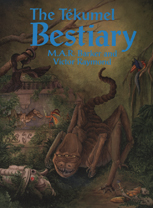 authors: M.A.R. Barker & Victor Raymond
authors: M.A.R. Barker & Victor Raymond
interior artist: Giovanna Fregni
cover artist: Giovanna Fregni
publisher: Theatre of the Mind Enterprises Inc.
publication date: 1992
cover: softcover
number of pages: 60
ISBN-10: N.A.
ISBN-13: N.A.
catalog number: TEK-1005
description: This book contains over 140 new creatures from the Tékumel campaign setting. This book is compatible with the Theatre of the Mind role playing game system.
Our featured entry from this bestiary is the akhó, "the embracer of ships".
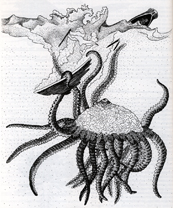 These sinewy, dull grey monsters range from small specimens about 10 feet in length, to the commoner size of 15-30 feet, to the largest individuals, which may be 50-75 feet long! Two years ago a dead Akhó was found washed up on a beach in Livyánu that must have measured nearly 100 feet long and 30 feet in diameter! The Akhó has twenty steel-hard tentacles (the largest are the thickness of ships' hawsers!) with which it seizes its victims. The creature has one glaring red eye set atop a cucumber-shaped body, beneath which lies its huge maw, filled with leafy membranous material which eats away a victim with an acid secretion. An Akhó usually attacks the hull of a ship, and larger specimens can crush it to splinters. The beast may also try to snatch defenders from the ship's decks with its tentacles. These monsters swallow almost everything they grab, and treasures have been found in the remains of dead Akhó, consumed who knows how long ago.
These sinewy, dull grey monsters range from small specimens about 10 feet in length, to the commoner size of 15-30 feet, to the largest individuals, which may be 50-75 feet long! Two years ago a dead Akhó was found washed up on a beach in Livyánu that must have measured nearly 100 feet long and 30 feet in diameter! The Akhó has twenty steel-hard tentacles (the largest are the thickness of ships' hawsers!) with which it seizes its victims. The creature has one glaring red eye set atop a cucumber-shaped body, beneath which lies its huge maw, filled with leafy membranous material which eats away a victim with an acid secretion. An Akhó usually attacks the hull of a ship, and larger specimens can crush it to splinters. The beast may also try to snatch defenders from the ship's decks with its tentacles. These monsters swallow almost everything they grab, and treasures have been found in the remains of dead Akhó, consumed who knows how long ago.
|
|
|
|
|
October 26, 2019
The Iron Heroes Bestiary
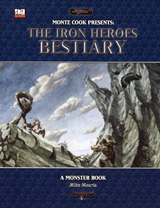 author: Mike Mearls
author: Mike Mearls
interior artist: Kev Crossley
cover artist: Jeremy Jarvis
publisher: Malhavoc Press
publication date: 2006
cover: softcover
number of pages: 96
ISBN-10: 1-58846-949-2
ISBN-13: 978-1-58846-949-6
catalog number: WW16156
description: This book contains more than thirty new creatures from the Iron Heroes campaign setting. This book is compatible with the d20 role playing game system.
Our featured entry from this bestiary is the dire gloom.
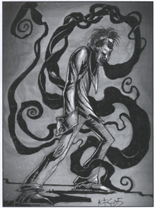 The dire gloom is a creature of liquid darkness that flows over its foes and drowns them in a chilling embrace. Its shape--if it can be said to have one--is hard to pin down because the undead beast roils endlessly across the ground or through the air. Most adventurers describe it as a bundle of inky streaks that coil and splash together in a motion that's almost hypnotic in its grace. But there's nothing delicate about the nasty manner in which it invades and destroys its victims.
The dire gloom is a creature of liquid darkness that flows over its foes and drowns them in a chilling embrace. Its shape--if it can be said to have one--is hard to pin down because the undead beast roils endlessly across the ground or through the air. Most adventurers describe it as a bundle of inky streaks that coil and splash together in a motion that's almost hypnotic in its grace. But there's nothing delicate about the nasty manner in which it invades and destroys its victims.
Like a living globule of water, a dire gloom can force itself down an opponent's throat and into his lungs, choking the life out of him. The dire gloom then slowly consumes its victim's life force, draining energy and consuming his physical body over the course of a week or two. In this state, the dire gloom uses the victim's body like an armored shell. From a distance, the dire gloom's disguise masks it from detection. A closer inspection, though, reveals several telltale signs of its presence. The shell body's eyes turn an inky black, and the body moves in a jerky, awkward manner.
The dire gloom arises in areas where the stuff of the Negative Energy Plane spills over into the mortal realm. Intelligent creatures slain by the influx of energy become dire glooms, chunks of negative energy given intelligence as the dying creature's soul becomes enmeshed within the stuff of the negative plane. Dire glooms are hateful beings, and they carry twisted, distorted memories of their lives.
While dire glooms delight in tormenting and slaying their prey, they are by no means mindless killers. Many of them develop class abilities, particularly spellcasting talents, while others work with evil cultists, high priests, and others who can furnish them with a steady stream of victims in return for service. In particular, they make excellent assassins.
|
|
|
|
|
November 2, 2019
Arcanis Bestiary Volume I
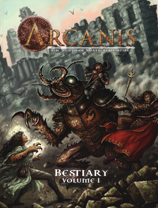 authors: Pedro Barrenechea, Jimmy Beck, Henry Lopez and Eric Wiener
authors: Pedro Barrenechea, Jimmy Beck, Henry Lopez and Eric Wiener
interior artists: Drew Baker et al.
cover artist: Pat Loboyko
publisher: Paradigm Concepts
publication date: 2011
cover: softcover
number of pages: 48
ISBN-10: 1-931374-51-1
ISBN-13: 978-1-931374-51-4
catalog number: PCI 1602
description: This book contains more than two dozen creatures from the Arcanis: The World of Shattered Empires campaign setting. This book is compatible with the Shattered Empires: Roleplaying in the World of Arcanis role playing game system.
Our featured entry from this bestiary is the pyrolengus, the flame tongue ss'ressen.
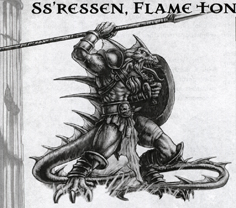 The Flame Tongue Egg Clutch was created as ranged support for the Ssethric forces but still maintained the capability for melee combat. Flame Tongue Ss'ressen stand between 5 and 6 feet tall; their hide is a dusky brown in coloration, mottled with orange or red bars. Flame Tongues sport a crimson red sagittal crest that lies flat against their back. When agitated or in preparing to use their unique attack, the crest is raised to display its vivid red coloration.
The Flame Tongue Egg Clutch was created as ranged support for the Ssethric forces but still maintained the capability for melee combat. Flame Tongue Ss'ressen stand between 5 and 6 feet tall; their hide is a dusky brown in coloration, mottled with orange or red bars. Flame Tongues sport a crimson red sagittal crest that lies flat against their back. When agitated or in preparing to use their unique attack, the crest is raised to display its vivid red coloration.
The Flame Tongues received their namesake from two specialized glands found in the rear of their jaws. When their facial muscles are contracted a stream of viscous oil is forcibly ejected from the glands and spurts out of its mouth in a tight stream. This oil ignites upon contact with the surrounding air, creating gout of sticky flaming napaltha. Knowledgeable opponents may gain a moment to prepare themselves by watching for the telltale crest moments prior to being immersed in liquid fire.
Flame Tongue Ss'ressen settlements are spread along the drier Northern Reaches of the Ssethregoran Empire. Before the appearance of the Altherians, the Flame Tongues controlled strongholds as far north as the Kuthre River, but the humans have driven them and other Ssethric forces south, out of the highlands and into the swamp...
|
|
|
|
|
November 9, 2019
Lord Erbian's Stellar Bestiary
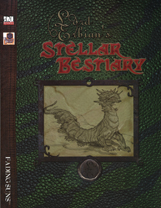 authors: David Blank et al.
authors: David Blank et al.
interior artists: John Bridges et al.
cover artist: uncredited
publisher: Holistic Design Inc.
publication date: 2002
cover: softcover
number of pages: 112
ISBN-10: 1-888906-34-0
ISBN-13: 978-1-888906-34-9
catalog number: FS #252
description: This book contains over 80 creatures for the Fading Suns space-fantasy campaign setting. This book is compatible with both the Victory Point System of Holistic Design Incorporated and the d20 system of Wizards of the Coast.
Our featured entry from this bestiary is the chusha t'ogh.
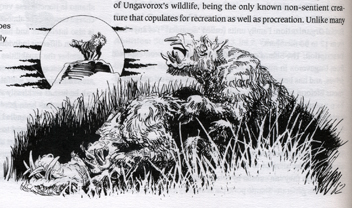 Description: The chusha t'ogh, or rutboar, is six-legged like its cousins, with an ugly wrinkled face, flaring nostrils and a mouth
full of tusks and fangs jutting out at odd angles. It is covered with soft brightly colored fur marked with striking patterns that seem to
act more as a signal to potential mates than as camouflage. Its hooves have a shiny, almost manicured, appearance. Its face, belly and bulbous warty rump are free of fur and lined with small nodules that are extremely sensitive. Each nodule is packed with sensory nerves as well as a large pheromone-secreting gland capable of shooting its load several meters with pinpoint accuracy.
Description: The chusha t'ogh, or rutboar, is six-legged like its cousins, with an ugly wrinkled face, flaring nostrils and a mouth
full of tusks and fangs jutting out at odd angles. It is covered with soft brightly colored fur marked with striking patterns that seem to
act more as a signal to potential mates than as camouflage. Its hooves have a shiny, almost manicured, appearance. Its face, belly and bulbous warty rump are free of fur and lined with small nodules that are extremely sensitive. Each nodule is packed with sensory nerves as well as a large pheromone-secreting gland capable of shooting its load several meters with pinpoint accuracy.
In addition to being a marsupial, a most interesting fact about the rutboar is that the entire species is hermaphroditic, possessing both male and female sexual characteristics. Some individuals may tend toward one gender or the other, but each is capable of both insemination and gestation. Two pairs of large teats sit far forward on the chest, giving the rutboar an almost humanoid-appearing cleavage when viewed directly from the front. Behind these, the marsupial pouch containing a pair of smaller teats opens to the rear; the birth canal beyond opens forward, almost directly into the pouch, thus eliminating the need for the newborn to climb into the pouch by itself. The rutboar's genitalia is overdeveloped with musculature that gives it prehensile capabilities, and is apparently able to adapt to intercourse with species other than its own. Furthermore, the rutboar is actually capable of impregnating itself, thus reproducing by parthenogenesis (or "virgin birth") when no breeding partner is available.
Behavior: The rutboar has one of the most notorious reputations of Ungavorox's wildlife, being the only known non-sentient creature that copulates for recreation as well as procreation. Unlike many of that planet's other species, it gives birth to, at most, only two or three young at a time, and so compensates by being in a constant state of sexual heat all year long throughout its adult life. Its family groups are small, and members leave to join other groups on an almost annual basis.
It is said that the rutboar will attempt to couple with anything it can reach that does not kill it first, and this is not far from the truth. (Lord Erbian's is informed that there are in existence certain private clubs catering to perverse fetishes which keep a rutboar around for this very purpose.) Voroxian legend contains incidences of rutboar successfully mating with other orders of mammalia, and even reptilia and aves. H.T. Hausen, a celebrated explorer during the Second Republic, claimed to have once seen a chusha t'ogh piglet emerge as part of a vrongar litter, and speculated that a rutboar had somehow transferred a prematurely delivered infant to the expecting vrongar mother during some bizarre mating attempt. The feral Vorox who accompanied him claimed this "surrogate birthing" was not uncommon and reminded him of the respect paid to the chusha t'ogh in the rites associated with the "Great Vrongar Hunt." (The vrongar is a giant reptiloid ceratopsid which bears live young; a wealth of information on this species can be found in the Vorox volume of the Alien Expeditions series, which Lord Erbian's recommends as a supplement to this Bestiary.) While other Republican xenobiologists and natural philosophers of our own era rejected this notion of interspecies breeding as mythic exaggeration, certain aspects of the rutboar's genetic composition remain a mystery, and biochemical interactions with other species have been noted. Its pheromones, in particular, have an arousing effect on most other races that reproduce sexually, including sentients.
Commodity: Hedgewitches and matchmakers throughout the Known Worlds prize rutboar products as ingredients for love potions, and even guild scientists aver that certain glands have definite aphrodisiac properties. Rutboar milk is said to be the sweetest there is, and at one firebird per liter it better be. Tusks may sell for three to five firebirds whole, or one crest per gram in powdered form. Pheromone glands are had for a firebird apiece, provided they were not damaged or punctured when removed. Rutboar pelts are considered attractive furnishings for bridal beds and love-nests, fetching 10 or more firebirds. Genitalia, if properly trimmed and preserved, can cost anywhere from 50 to 100 lb depending on size and articulation. Outlaw geneticists may pay hundreds of firebirds for rutboar semen, ova and amniotica.
(Lord Erbian's readers should be warned that most rutboar products sold outside of Li Halan space are falsely advertised as such, and are usually harvested from common boars of other worlds.)
|
|
|
|
|
November 16, 2019
A New World Bestiary
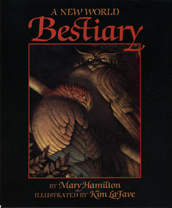 author: Mary Hamilton
author: Mary Hamilton
interior artist: Kim LaFave
cover artist: Kim LaFave
publisher: Douglas & McIntyre
publication date: 1985
cover: hardcover
number of pages: 40
ISBN-10: 0-88894-485-3
ISBN-13: 978-0-88894-485-6
description: This book contains description of creatures of the American continents as described by early European explorers. This book is not intended to be compatible with a role playing game system.
Our featured entry from this bestiary is the skrelling.
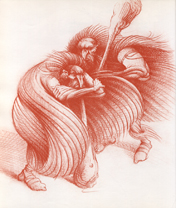 The Norse people were also threatened by strange Arctic creatures that lay in wait for them. They were "fierce fighters, small like pygmies, horribly ugly and covered with hair."
The Norse people were also threatened by strange Arctic creatures that lay in wait for them. They were "fierce fighters, small like pygmies, horribly ugly and covered with hair."
These Skrellings terrorized the Norse settlers by yelling and shooting arrows at them. The Norsemen were forced back to Iceland, but soon returned with Thorfinn Karlsefni as their leader. For a time all went well, but one day the Skrellings attacked again, using arrows and a powerful pole with a "large knob on the end, black in colour and about the size of a sheep's belly, which flew ... over the heads of the men and made a frightening noise when it fell." Only the bravery of Eric the Red's daughter, Freydis, saved the Norsemen that day! The attackers fled when she ran towards them, screaming and slapping a sword across her bare breasts.
Hundreds of years later a noted anthropologist, Franz Boas, heard about these creatures from his Inuit guides. The Inuit called them Ardnainig and said: "they are as small as children and completely covered with hair. Their wives who are of normal size carry their little husbands about in their hoods."
Were these creatures an unknown tribe of native people? Or were they, as Professor Tryggor Oleson believes, a primitive pre-Dorset race which long ago became extinct? This would support Captain Luke Foxe's claim that in 1631, while searching for a North-west Passage, he found the graves of people who were less than four feet tall.
|
|
|
|
|
November 23, 2019
Monsters and Creatures: A Young Adventurer's Guide
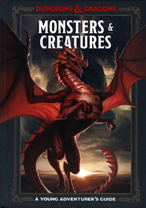 author: Jim Zub
author: Jim Zub
interior artists: uncredited
cover artist: uncredited
publisher: Ten Speed Press
publication date: 2019
cover: hardcover
number of pages: 106
ISBN-10: 1-9848-5640-5
ISBN-13: 978-1-9848-5640-1
description: This book contains 37 creatures for a classical fantasy-based campaign. This book is compatible with the Dungeons and Dragons Role Playing Game.
Our featured entry from this bestiary is the beholder.
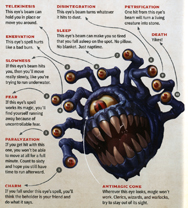 Beholders are freaky floating creatures with shimmering eyes that cast evil spells. Is that big blob the beholder's head or its body? Are those eyestalks coming out of the top its hair or its limbs? There are no easy answers. All you need to know is that a beholder is a scary floating eyeball monster. And if any of those eyes set their gaze on you, you're in big trouble. Beholders are jealous, angry creatures. They have such a bad attitude that they don't even get along with each other (which is actually a good thing because if you found more than one at the same time you'd probably be a goner).
Beholders are freaky floating creatures with shimmering eyes that cast evil spells. Is that big blob the beholder's head or its body? Are those eyestalks coming out of the top its hair or its limbs? There are no easy answers. All you need to know is that a beholder is a scary floating eyeball monster. And if any of those eyes set their gaze on you, you're in big trouble. Beholders are jealous, angry creatures. They have such a bad attitude that they don't even get along with each other (which is actually a good thing because if you found more than one at the same time you'd probably be a goner).
LAIR Most beholders live in remote places such as caves or abandoned ruins. Some of them even build their own lairs by disintegrating rock with their eye blasts in order to create tall tunnels where they can float above their prey and cause trouble. The floor of a beholder's cave is usually covered with treasure and equipment from unfortunate adventurers who didn't think to look up when they walked in the entrance.
SIZE Some beholders are small like a basketball, but older ones can be massive, more than ten feet in diameter, like a humongous beachball.
|
|
|
|
|
November 30, 2019
Pathfinder Bestiary, 2nd Edition
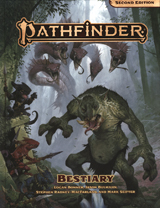 development leads: Adam Daigle, James Jacobs & Patrick Renie
development leads: Adam Daigle, James Jacobs & Patrick Renie
creative director: James Jacobs
interior artists: Klaher Baklaher et al.
cover artist: Wayne Reynolds
publisher: Paizo Publishing
publication date: 2019
cover: hardcover
number of pages: 358
ISBN-10: 1-64078-170-6
ISBN-13: 978-1-64078-170-2
catalog number: PZO-2102
description: This book contains over 400 creatures for a fantasy campaign. This book is compatible with the Pathfinder 2nd Edition Role Playing Game.
Our featured entry from this bestiary is the chuul.
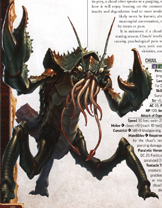 Also known as chu'ulothis, these large, armor-plated, crustacean predators lurk beneath the surface of pools, mires, and ponds, waiting to snatch up prey with their massive claws before paralyzing them with their tentacles. At that point, they begin to feed, eating their quarry alive.
Also known as chu'ulothis, these large, armor-plated, crustacean predators lurk beneath the surface of pools, mires, and ponds, waiting to snatch up prey with their massive claws before paralyzing them with their tentacles. At that point, they begin to feed, eating their quarry alive.
Chuuls can live in fresh or saltwater, and indeed are found in aquatic environs the world over—even in subterranean oceans and lakes.
While chuuls are good swimmers, they prefer terrestrial prey. Their preferred method of hunting is by lunging out of the water, paralyzing their victims with their poison-coated tentacles, then gleefully dragging their twitching food into the water to drown if they cannot simply eat such morsels alive. Chuuls that dwell aboveground prefer to dine on lizardfolk, while those swimming in subterranean lakes readily eat anything but xulgaths, whose flavor and stink they find off-putting.
Chuuls are capable of speech and reason, but these creatures rarely speak with those outside their species except to taunt their food. Before it begins consuming its prey, a chuul often speaks in a gurgling, nearly incomprehensible dialect about how it will enjoy feasting on the creature's flesh. Perhaps chuuls believe that insults and degradation lead to more tender and tastier food, but the truth will likely never be known; almost all chuuls stubbornly refuse any meaningful conversation, even when imprisoned and compelled by treats or pain.
It is unknown if a chuul society exists beyond their frenzied mating season. Chuuls' intellects seem devoted only toward eating, causing psychological pain to sentient creatures, decorating their lairs with mementos of their favorite meals and victories, and breeding.
|
|
|
|
|
December 7, 2019
Starfinder Alien Archive 3
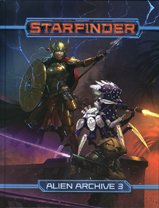 development lead: Joe Pasini
development lead: Joe Pasini
authors: Saif Ansari et al.
creative director: Robert G. McGreary
interior artists: Enrique Barajas et al.
cover artist: Remko Troost
publisher: Paizo Publishing
publication date: 2019
cover: hardcover
number of pages: 160
ISBN-10: 1-64078-149-8
ISBN-13: 978-1-64078-149-8
catalog number: PZO-7111
description: This book contains over 100 creatures for a science fiction campaign. This book is compatible with the Starfinder Role Playing Game.
Our featured entry from this bestiary is the space-faring cameloid, the dromada.
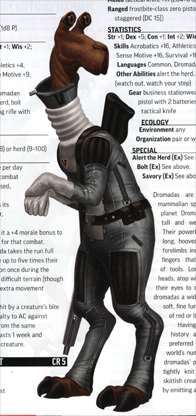 Dromadas are members of a bipedal mammalian species from the Near Space planet Dromaritia that average 5 feet tall and weigh around 200 pounds.
Their powerful unguligrade legs end in long, hooved toes, while their shorter forelimbs include strong dewclaws and fingers that allow the manipulation of tools. Long necks end in drooped heads, atop which stubby eyestalks allow their eyes to move independently, giving dromadas a wide field of vision. They have soft, fine fur that can be various shades of red or brown.
Dromadas are members of a bipedal mammalian species from the Near Space planet Dromaritia that average 5 feet tall and weigh around 200 pounds.
Their powerful unguligrade legs end in long, hooved toes, while their shorter forelimbs include strong dewclaws and fingers that allow the manipulation of tools. Long necks end in drooped heads, atop which stubby eyestalks allow their eyes to move independently, giving dromadas a wide field of vision. They have soft, fine fur that can be various shades of red or brown.
Having spent most of their history as the most populous and preferred prey animal for their home world's numerous large carnivores, the dromadas' presapient ancestors formed tightly knit herds to keep safe. The skittish creatures reacted to danger first by emitting a deep moan that would alert the entire herd, then bolt for safety in huge stampedes. As they gradually learned to use tools, communicate with spoken language, and develop more advanced technology, dromadas retained these behaviors, which continue to serve them well even as they join the galactic community. While dromadas are a sapient species and as such are not considered food to most other sapient species, there are a few evil species willing to go to great lengths to obtain dromada meat, which is reported to have a unique and savory flavor...
Dromadas do not consider leadership of a dromada herd to be an honor or something to aspire to, as leaders become targets simply by virtue of their position. Most dromada herds elect their leaders democratically and for limited terms, but because an average dromada has no interest in taking on a leadership role, the herd itself nominates candidates for political office-whether an individual wants to run or not. Rather than focusing on their own achievements, many candidates instead highlight the accomplishments of their opponents in hopes of losing the election to someone else...
|
|
|
|
|
December 14, 2019
Rifts Bestiary Volume One
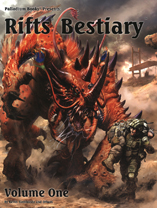 authors: Kevin Siembieda et al.
authors: Kevin Siembieda et al.
interior artists: Robert Atkins et al.
cover artists: Charles "Chuck" Walton Jr. & Eduardo Dominguez S.
publisher: Palladium Books
publication date: 2019
cover: softcover
number of pages: 256
ISBN-10: 1-57457-268-7
ISBN-13: 978-1-57457-268-1
catalog number: 896
description: This book contains over 80 creatures, whose names begin with the letters A through F, for a campaign set in the fictional worlds of Rifts. This book is compatible with the Rifts and Megaverse Role Playing Games.
Our featured entry from this bestiary is the demon beaver, the wishpoosh.
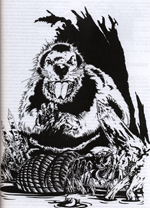 Though the Rifts Bestiary's focus is mortal beasts, not demons and spirits, we have made a few exceptions when it is either unclear the creature is a demon/supernatural or if the monster is driven by instinct and more animal than human. This is one such creature.
Though the Rifts Bestiary's focus is mortal beasts, not demons and spirits, we have made a few exceptions when it is either unclear the creature is a demon/supernatural or if the monster is driven by instinct and more animal than human. This is one such creature.
As their name suggests, Demon Beavers are giant rodents, 15 feet (4.6 m) long from snout to rump, or tall when sitting upright on their haunches, plus another 8 feet (2.4 m) for their large, flat beaver tail. The paws on their front legs look more like clawed hands with an opposable thumb, and their eyes twinkle with intelligence and wicked intentions.
A giant, Demon Beaver may sound silly, but it is no laughing matter. Face to face, the beast can kill a person as easily as a Demon Bear, and they are a terror to sailors and fishermen on the rivers and lakes of Canada and the Northern United States.
A Wishpoosh is considered to be a demon or evil spirit that takes the form of a wicked beast that resembles a giant, monstrous beaver. Legends of the Nez Perce of the Northern Plains warn of a Demon Beaver. One story speaks of a time in which the wicked Wishpoosh was preventing the Nez Perce from fishing. Fearing they would starve, the people managed to convince Coyote (the Trickster) to help them. Coyote attacked Wishpoosh by leaping on his back and stabbing him with a huge spear, but the monster still lived and swam away with Coyote still on his back. Ever the cunning Trickster, Coyote transformed himself into a fir branch, which Wishpoosh swallowed. Inside his enemy's belly, Coyote changed into human form and gutted the beast from the inside, killing it. This tale suggests that there might only have been one Wishpoosh, for the Demon Beaver is not mentioned again. However, this is not the case. Since the Coming of the Rifts, the Wishpoosh or Demon Beaver has returned. Their numbers are very small and they typically are lone bringers of trouble and sorrow, but the beast creates serious, life threatening problems wherever one appears.
The wicked beast is something of a mischievous, evil trickster that enjoys causing trouble and grief for humans and D-Bees. Nowhere
near as imaginative or cunning as the legendary Coyote, Demon Beavers use cruel tricks, intimidation tactics, surprise attacks
and the same stunts repeatedly to hurt mortals. A Demon Beaver likes to cause trouble by chasing away fish,
capsizing boats, poking or biting a hole in a canoe or small boat to watch it slowly sink and enjoy the spectacle of the people inside
panicking and rushing to shore or drowning, pulling swimmers underwater to drown, creating weak spots and holes in the ice of
frozen lakes, as well as biting fishing lines, hooking sunken logs or debris to fishing lines, snapping/gnawing through anchor chains to
set water vessels loose from their moorings, rocking and shaking large vessels, knocking on the hull to awaken or frighten the crew,
and, if the vessel is small enough (weighing less than 8 tons), grabbing the anchor and pulling the boat in a zigzag pattern all over the river or lake before finally letting it loose or trying to tip it over. The Demon Beaver also likes to create traps involving felling trees on land and along waterways as well as blocking waterways with logs and debris, channeling water to flood a road, trail or crops, and so on. Note: A Wishpoosh can topple a full-sized tree by gnawing through it in 1D4 minutes and tear saplings and young trees out by the roots.
The Demon Beaver's favorite two tricks are causing floods and changing the direction/shape of waterways. This is done by creating dams, or sabotaging man-made ones, to redirect the water. Masterful damn builders themselves, Demon Beavers can also summon, control and direct ordinary beavers to do their bidding...
|
|
|
|
|
December 21, 2019
Numenéra: The Ninth World Bestiary 3
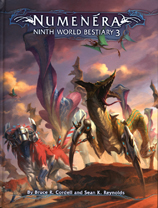 authors: Bruce R. Cordell & Sean K. Reynolds
authors: Bruce R. Cordell & Sean K. Reynolds
interior artists: Eren Arik et al.
cover artist: Lie Setiawan
publisher: Monte Cook Games
publication date: 2019
cover: hardcover
number of pages: 192
ISBN-10: 1-939979-92-7
ISBN-13: 978-1-939979-92-6
catalog number: MCG168
description: This bestiary is compatible with the Numenéra Role Playing Game.
Our featured entry from this bestiary is the kodymir.
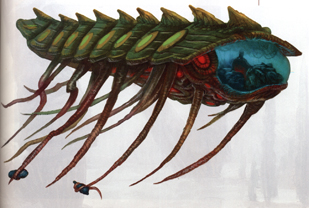 Bridging the gap between creatures and vehicles, kodymirs are wagon-sized arthropods with segmented hard shells and twenty or more whiplike appendages they use to swim. Its body is mostly an open gullet, and it eats by siphoning water through its mouth, filtering out tiny animals and plants, and expelling water out its back end. A kodymir's brain is in the bottom of its mouth and is connected to a numenera interface, allowing a skilled user to control the creature like a vehicle. The kodymir can fill its gullet with an oxygenated transparent gel that surface creatures can breathe, allowing it to submerse and travel a long distance underwater while carrying up to eight human-sized creatures within its body. The gel hinders all tasks of the passengers, but still allows the kodymir to catch food as it swims. Large glassy eyes along the creature's body allow passengers to see outside.
Bridging the gap between creatures and vehicles, kodymirs are wagon-sized arthropods with segmented hard shells and twenty or more whiplike appendages they use to swim. Its body is mostly an open gullet, and it eats by siphoning water through its mouth, filtering out tiny animals and plants, and expelling water out its back end. A kodymir's brain is in the bottom of its mouth and is connected to a numenera interface, allowing a skilled user to control the creature like a vehicle. The kodymir can fill its gullet with an oxygenated transparent gel that surface creatures can breathe, allowing it to submerse and travel a long distance underwater while carrying up to eight human-sized creatures within its body. The gel hinders all tasks of the passengers, but still allows the kodymir to catch food as it swims. Large glassy eyes along the creature's body allow passengers to see outside.
|
|
|
|
|
December 28, 2019
The Untamed Beastiary: A Field Guide to Marvelous Monsters
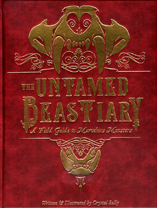 author: Crystal Sully
author: Crystal Sully
interior artist: Crystal Sully
cover artist: Crystal Sully
publisher: Untamed Beasts, LLC.
publication date: 2019
cover: hardcover
number of pages: 100
ISBN-10: none
ISBN-13: none
catalog number: none
description: This bestiary contains descriptions of 48 fantastic creatures from various environments distributed around the world. It is not associated with any particular Role Playing Game.
Our featured entry from this bestiary is the flora nautilus-labrusca.
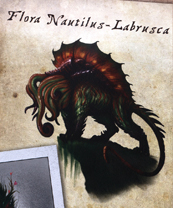 In my travels I have happened upon several different variations of a new category of creature. These beasts are not plant nor animal but exist in the gap between. Their bodies are a deadly network of plant matter but behave more like predators. These creatures are often found in sunny patches or in trees, holding perfectly till for months on end, waiting for their prey to unwittingly stumble into striking range. The next time you see a dangling vine, think twice before brushing it aside.
In my travels I have happened upon several different variations of a new category of creature. These beasts are not plant nor animal but exist in the gap between. Their bodies are a deadly network of plant matter but behave more like predators. These creatures are often found in sunny patches or in trees, holding perfectly till for months on end, waiting for their prey to unwittingly stumble into striking range. The next time you see a dangling vine, think twice before brushing it aside.
Only having seen this bizarre creature from afar, I can only guess at its composition. Where the face would be appears to be vines replicating tentacles of a nautilus. Its eyes are placed far to the side on stalks, resembling a hammerhead shark.
|
|
|
|
|
Continue to 2020 entries.
|
|
|
|
|
|
|
|

